Don't wanna be here? Send us removal request.
Text
How to Use Google Scholar to Effectively Do Your Assignment

Introduction How to use Google Scholar to effectively do your assignment may not be something you think about when doing assignments. If this is true for you, you should. Think about it this way, if you were studying for an undergraduate degree, you will probably use Google Scholar for every written assignment. That’s a lot of usage if you were to consider how many assignments you would have done when you graduate. This means that it makes a lot of sense to have a strategy on how to effectively use it for any assignment. This article will give you some tips on how to use Google Scholar with other techniques to smash your assignment. Specific Questions The first step is to be specific about the articles or other materials you are looking for. You need a clear understanding of your assignment topic and questions to do this. The topic will provide the general context within which you can answer the assignment question(s). Clarity about the question will help you pull out what to specifically search on Google Scholar. In the questions below, there are three main topics, internet marketing, 7Ps and globalisation.

There are thousands of articles and materials about these topics in many different situations on Google Scholar. In this case, the specific search phrase to ask Google Scholar will include the benefits/opportunities of internet marketing. This will provide sources to read, cite and apply to the chosen business using examples. Other specific phrases will include ‘7Ps and internet marketing’ ‘globalisation challenges and internet marketing’ internet marketing and business performance’ principles of internet marketing’ challenges of internet marketing. Google Scholar Usage After having the specific search phrases ready the next step is to access Google Scholar via scholar.google.com. Typing the search terms in the search bar will produce good sources to pick from. However, you can make your search more specific by using the advanced search option via the menu icon (three horizontal lines) at the top left corner of the home page. This will allow you to refine your search by specifying keywords, authors, publication dates, and more. Boolean Operators can also be used here for more specific searches. Titles and Excerpts Before you start to open the articles to decide on the suitable ones for your assignment, scan through the titles and excerpts. This will help you quickly identify the articles that are worth exploring further. For example, searching one of the search phrases will return the following articles:
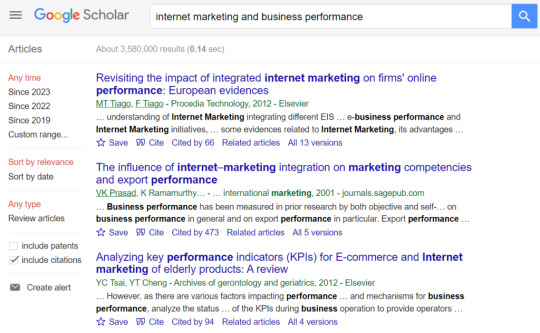
The first article seems useful, and so does the part of the second that looks at business performance in general. However, the part that focuses on export may not be relevant if you are using a business that doesn’t export for the assignment. The third doesn’t seem relevant except the business that you chose for your assignment sells elderly products. Abstract and Introduction If an article seems relevant, click on the title to access the full text. Then read the abstract and introduction to be clear if it is definitely relevant. In some cases, the article may be freely available, while in others, you may be prompted to pay or log in through a university library system. Learn how to take advantage of your institution's library resources to access paid articles here. Citation List One useful feature of Google Scholar is the "Cited by" link that appears below each search result. Clicking on this link will show you a list of other articles that have cited the original article. This can be helpful in finding additional relevant sources. There are 66 in the first and 473 in the second article. Related Articles Google Scholar also provides related articles and recommendations based on the article you're currently viewing. These suggestions can lead you to other sources that may be valuable for your assignment. For more recent cited-by and related articles, you can customise the search result to the current year on the left-hand side. Source Credibility

You can’t use all the suitable sources that you find. You have to use credible ones. The credibility of the sources used goes a long way in determining the standard of the perspectives, views, arguments in your assignment. The same for the standard of the analysis in your work as the assignment requires. Assess the credibility, relevance, and authority of the authors using the CRAAP and other techniques. Consider factors like the journal's reputation, the peer-review process, and the author's credentials. Citation Trails Once you find a useful article, explore its references to find additional sources that are cited within. This technique can help you discover more relevant articles and build a stronger foundation for your assignment. Conclusion Remember, Google Scholar is just one tool among many for academic research. While it can be a valuable resource, it's important to explore other databases, library catalogues, and disciplinary repositories to ensure you have a comprehensive collection of relevant sources for your assignments. Finding the right sources is an excellent step towards doing your assignment the right way. However, how well you use the sources to answer the assignment question will determine the grade you get. This is why it is very important to learn how to answer assignment questions as your lecturer expects you to. Read the full article
#AccessGoogleScholar#CitationListonGoogleScholar#CitationTrailsGoogleScholar#CRAAP#HowtoUseGoogleScholartoEffectivelyDoYourAssignment#RelatedArticlesonGoogleScholar#Rightsearchcommandongooglescholar#Sourcecredibility#SpecificQuestionsonGoogleScholar
0 notes
Text
How to Submit Your Assignment on Turnitin and Check for Plagiarism
Introduction
If you are a college or university student, chances are you have wondered how to submit your assignment on Turnitin and check for plagiarism. This is because most written assignments at university are submitted on Turnitin. However, if you haven’t used Turnitin before you won’t know how to do both properly, especially to check for plagiarism. It is very important to learn how to do this so that you don’t end up in an unintended plagiarism situation. Also, because of plagiarism, it is possible to fail an assignment and end up having to do it all over. Knowing how to check for plagiarism will help you avoid this. Instead, you are able to correct the parts of your work that should have resulted in plagiarism before the final solution.
How To submit your Assignment on Turnitin
The first step is to identify the submission link. This will be in your university virtual learning environment (VLE). The learning environment normally goes by different names such as VLE, Moodle, Blackboard or Canvas. It is called iLearn at Arden University. Your lecturer will show you this link or how to access it. Once you click on the submission link, it will take you to the Turnitin page that is embedded within the VLE. Then, once on the page, click where it says to “Submit Paper”. In some VLE you will have the upload button or icon. Although there are different variations, the submission page will normally look like the image below:

The next step is to drag your written assignment into the circled part with the number one. You would have done the assignment on Microsoft Word or PowerPoint already. And saved a copy on your computer. Learn how to do your assignment on Microsoft Word and PowerPoint here. After you drag and drop your assignment, you must add a title where it shows the number two and click on “Add Submission”, which is number three.
How to Check for Plagiarism on Turnitin
Besides using Turnitin to mark your assignment and give you feedback, it is used to check for plagiarism. However, to use Turnitin to check for plagiarism, it should be during draft submission. Alternatively, submit your work in the final submission link a good time earlier than the deadline. Then, check for plagiarism and submit it again after corrections. You should check with your lecturer if multiple submissions are allowed before the final submission. If multiple submissions are not allowed, you can’t use the final submission link to check for plagiarism. The steps and images below will guide you on how to use Turnitin to check for plagiarism. After you submit your assignment, the following page will show in your submission inbox:

Under the heading that says “Similarity”, the extent to which your submission is similar to other resources on the internet, student submissions in other universities and previously submitted work will show in percentage. In our example, it is 100%. This means that the entire submission is similar to either a source on the internet or a previously submitted work. To find out more on the next page, click on the similarity percentage and it will show the following page:
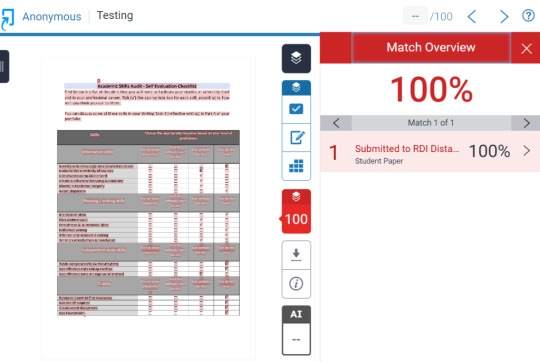
Beneath the 100%, it shows that this is a previously submitted work. In the following example, 41% of the work is similar to online sources and a previously submitted work:

After opening the similarity percentage, when you click on the red similarity tool (1) and the similarity percentage (2) as shown below:

You will see the following:
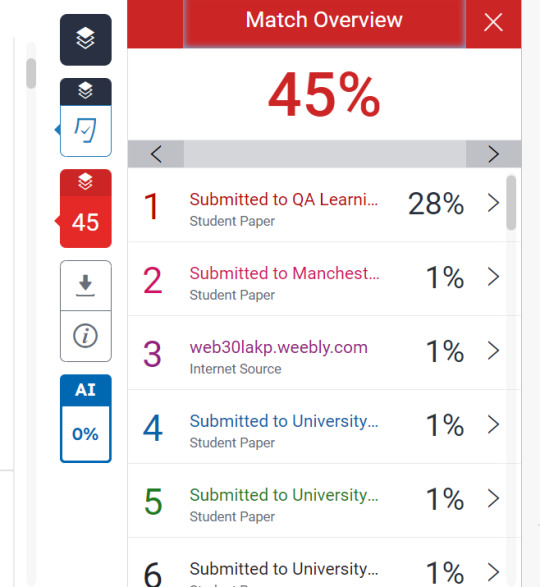
This shows the different sources that parts of the work is similar to and the extent to which it is similar to them (%). When the similarity percentage is because your submission is similar to a template, heading, references or in-text citation this is acceptable. It is not a problem. However, when the similarity percentage is because of the assignment answer that you have written it can be plagiarism. This means that the part of your answer with the similarity percentage is the same as either a previous submission or sources on the internet. The lecturer will click on each to view the source. How to check lecturer feedback To view the feedback that the lecturer gave you, click on the blue pen and paper as shown below:
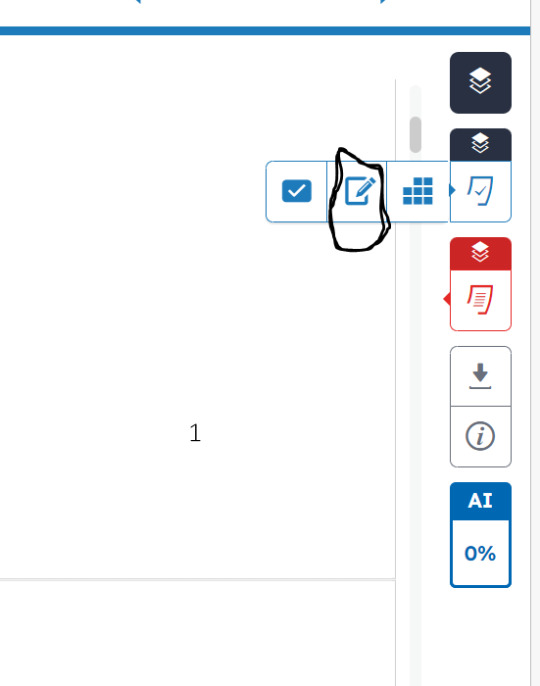
It will open the following comment box shown below:
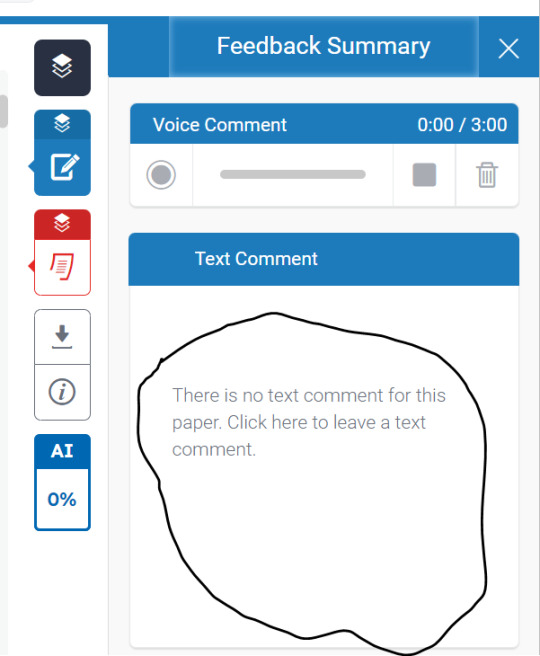
In addition to the similarity percentage and feedback tabs discussed the other tabs are useful in a variety of ways. For example, the download button is used to download your work after checking similar parts to edited them in your Word copy. Also, the recent AI tab is used to check the extent to which a submission is written by artificial intelligence such as ChatGPT. Check out more tips on how to use Turnitin from London School of Economics here
Conclusion
Using Turnitin to check for plagiarism has many factors to consider. It is always best to speak with your lecturer about these factors. An important one is the similarity percentage that becomes plagiarism. It is not straightforward to determine a specific percentage that constitutes plagiarism. A rule of thumb is to reduce the similarity percentage as much as possible, especially for the part of your submission that is your answer. Once you learn how to check your work for plagiarism and do the corrections, you will never be at risk of submitting a plagiarised work unintentionally. Read the full article
#HowtoCheckPlagiarismonTurnitin#HowtoSubmitYourAssignmentonTurnitinandCheckforPlagiarism#HowtoSubmitYourWorkonTurnitin#Plagiarism#Turnitin
1 note
·
View note
Text
How to Use Office 365 Suite to Effectively Study and Do Assignments

Introduction
If you find it challenging to use Office 365 Suite to effectively study and do assignments, this article will liberate you from the struggle. It is common for students who are not tech-savvy to struggle with the use of digital technology when studying or doing assignments. Despite this struggle, the use of digital platforms in higher education is fast becoming the norm. This trend will only continue at a fast pace. Some popular digital platforms used while studying are Online Libraries, Google Scholar, Moodle, Virtual Learning Environment (VLE), Turnitin, Kahoot, Padlet, Miro, and Nearpod, and many more. There is no way to avoid using digital technology for higher education students or aspiring students even if you don’t like it. The only option is to learn how to use the ones that are used as part of your course. This is one of a series of articles on how to use these digital platforms. The focus of this article will be on the Microsoft Office 365 Suite which is popularly used in higher education, especially Word and PowerPoint.
How to Use Microsoft Word for Studying and Assignments
Using Microsoft Word for studying and assignments will help you in several ways. For example, to organise your thoughts, take notes, and create well-structured documents. Below is a step-by-step guide on how to use Microsoft Word to study and for assignments with pictures: How to Create a New Word Document You can create a document in two ways. Either on the internet or as an app. Using Microsoft Word on the internet is always better than the app. This is because you can access your study notes or assignment anywhere via the internet. You only need your username and password. When you use the app, you can only access it on your computer or the device you saved the app. The steps below are on the 2021 version of Office 365 (on a laptop), it will be the same for similar versions. How to Open Microsoft Word on the Internet: Sign into your Office 365 account using the email address that your university or college gave you. To do this, type office.com in your browser:
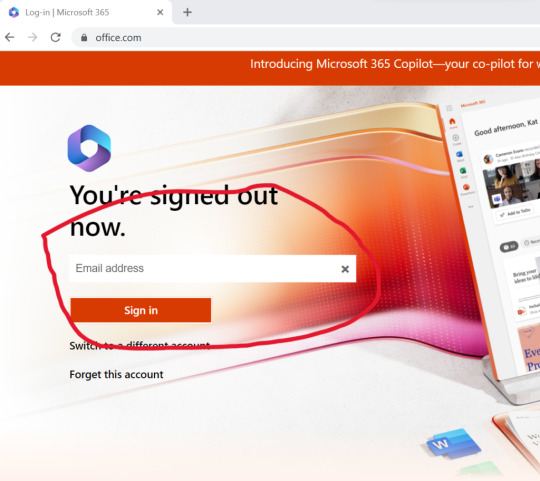
You will see the page below once signed in:
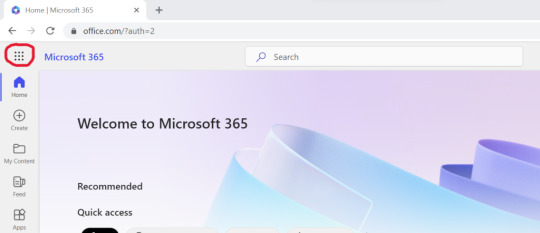
Click on the nine dots circled in red on the top left of the page and you will see the following:
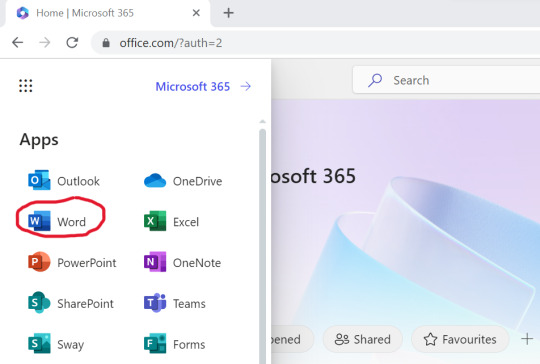
Click on “Word” and you will see the page below:
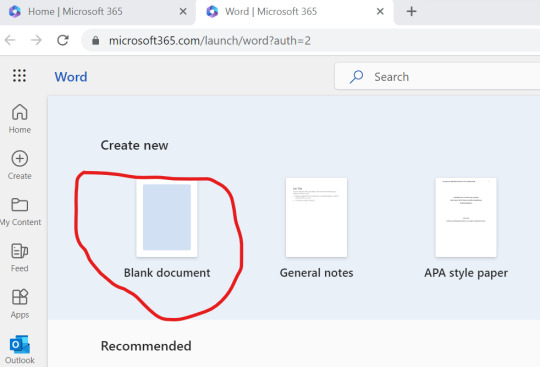
Click on "Blank Document" and you will see the following page:
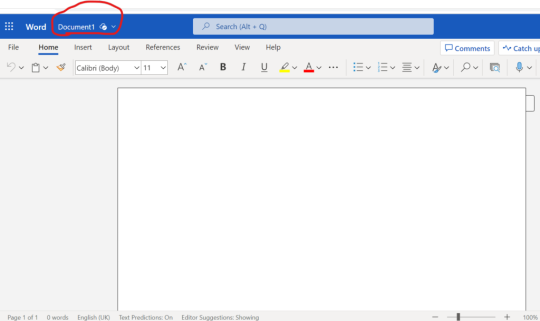
Click on Document 1 to save it with a unique name. This will help you easily identify the document when you intend to open it another time. Use the name of the module and/or the assignment. For example, “Academic Skills Practice Assignment”:

When you sign into your Office 365 account another time the saved work will be displayed as follows (there will be a list as you save more):
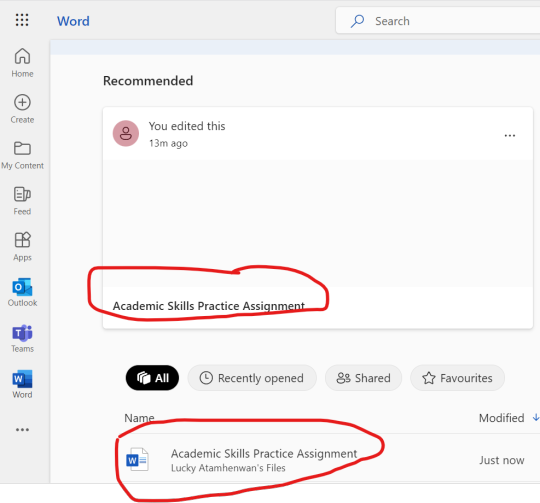
To save Word on your computer, click on “Editing” then “Open in Desktop” in the dropdown. After it opens as an app, then save it to your computer.

Formatting and Styling Use the formatting options in the toolbar to adjust the font, size, and style of your text:

To see more options, click on the ribbon display option and select “Classic Ribbon”, the following will show:


Always use headings and subheadings to organise your assignment answers and notes. Select the text you intend to make a heading and choose appropriate heading styles from the "Styles" menu (circled in red in the image above). To insert a picture, click on the "Insert" tab in the toolbar and click on "Pictures" to choose an image from your computer or other sources. You can also insert tables shapes, web links, videos, comment and headers and footers such as page number:
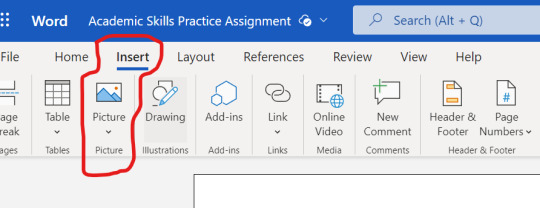
Table of Contents If your document has several sections or headings, you can create a table of contents to easily navigate through the content. Put your cursor where you want to insert the table of contents. Go to the "References" tab and click on "Table of Contents." Choose the desired style:
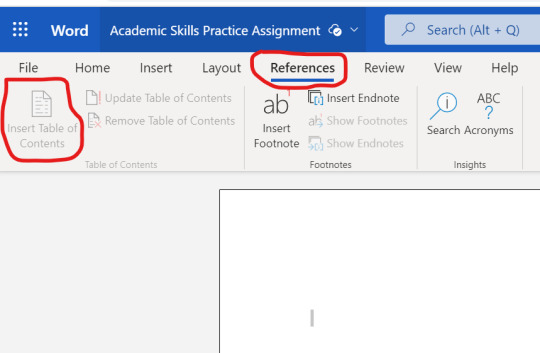
How to Use PowerPoint for Assignments
Microsoft PowerPoint is a useful tool for creating engaging presentations, study guides, and interactive content. Below is a guide on how to use Microsoft PowerPoint for assignments and studying: Creating a New Presentation After clicking the nine dots as shown above, click on PowerPoint (Some of the other useful apps for studying such as OneNote, Excel and Teams are underlined):
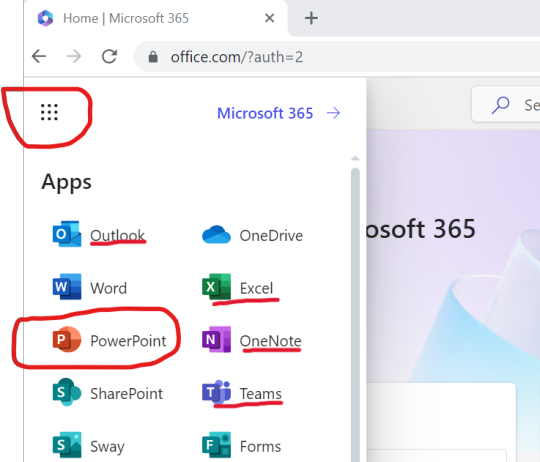
Then click on “blank presentation” for a plain version or click on any of the other templates provided such as Madison, Atlas, and Gallery:
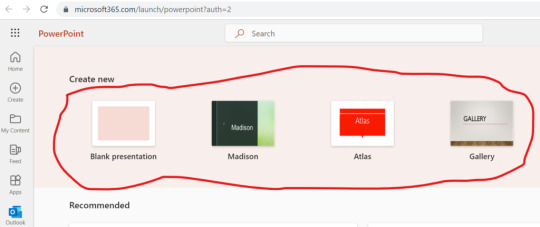
Once the slides open, you can change the layout by clicking on the “Home” tab and “slide layout”.
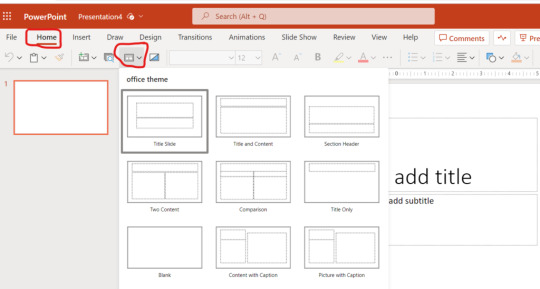
After adding a title and subtitle, right-click on slide number one to add a new slide:
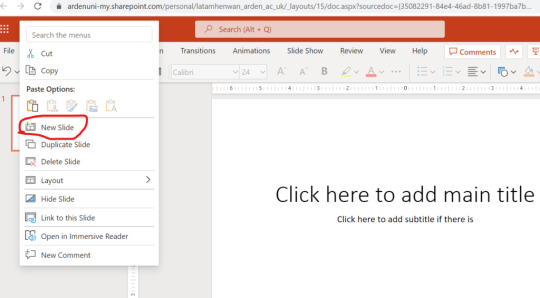
Open the classic ribbon as shown above and use the formatting options in the toolbar to change font styles, sizes, colours, and alignments. You can also insert pictures, images and so on as shown above. See more tips on how to use PowerPoint here.
How to Use OneNote for Studying
OneNote is an ideal digital note-taking app that allows you to take notes, draw diagrams, and clip web content. It helps to organise your notes into sections and pages, making it easy to find and review information later. You can also use tags to categorise and highlight important points. Collaboration enables you to share notebooks with study groups to facilitate collaborative note-taking information sharing. Also, you can record lectures or discussions and synchronise the audio/video with your notes for a comprehensive review. Check out some more tips on using OneNote here
How to Use Teams for Studying
Microsoft Teams is a good app for virtual collaboration. Joining or creating study groups on Teams allows group study flexibility in ways that face-to-face studying does not. Other benefits of using Teams for studying include conducting discussions, sharing files, and collaborating on projects or assignments in real-time. Features like video calls, screen sharing, and chat enhance remote learning experiences. These are the basic things to do with Microsoft Teams as a student.
How to Use Microsoft Outlook to Study
Of the many tools within Outlook, calendar and task management are two that help to study effectively. Use the Outlook calendar to schedule study sessions, set reminders, and create to-do lists. Stay organised by managing deadlines and tracking progress. Email and communication are other good uses. Also, to communicate with professors, classmates, or study partners using the email and messaging features. Others are to exchange study materials, clarify doubts, and collaborate effectively. Find many more tips on using Outlook here.
Conclusion
Effective studying involves a combination of utilising appropriate tools, creating a structured study plan, practising active learning, and managing your time effectively. Office 365 Suite is a very versatile and powerful aid in achieving these goals. Using the different Office 365 apps for studying and assignments help you get better at using them. This will put you in good stead when you start working. You don’t have to learn how to use them from scratch. This would also help you sharpen your transferable skills, which are highly desirable by employers and to successfully run a business. Drop your questions (and thoughts) in the comment box below. Read the full article
#CreateaNewPresentationonPowerPoint#CreateaTableofContentsonWord#FormattingandStylingonWord#HowtoCreateaNewWordDocument#HowtoUseMicrosoftOutlooktoStudy#HowtoUseMicrosoftTeamsforStudying#HowtoUseMicrosoftWordforStudyingandAssignments#HowtoUseOffice365SuitetoEffectivelyStudyandDoAssignments#HowtoUseOneNoteforStudying#HowtoUsePowerPointforAssignments#HowtoUsePowerPointtoStudy
0 notes
Text
Why Should I Study in the United Kingdom Instead of Another Country?

Introduction
Have you thought about studying abroad and wondered why should I study in the United Kingdom (UK) instead of another country? Or you are currently studying in the UK but haven’t thought about the benefits of studying here. This article will cover some of the benefits of studying in the UK along with some drawbacks. Knowing these benefits and drawbacks will help you decide if studying in the UK is suitable for you. Also, if you are already studying here, you can exploit some of the benefits and avoid the drawbacks where possible.
Advantages of Studying in the United Kingdom
There are several advantages that make Studying in the UK attractive. Below are some reasons to consider studying in the UK as an international student: Good Academic Reputation



The UK is known for academic excellence around the world. There are many prestigious universities known for their high-quality education. Some examples are the University of Oxford, the University of Cambridge, Imperial College London, and the London School of Economics and Political Science. These universities and many others consistently rank among the top universities globally. The same national education standards that regulate these popular universities also apply to many less-popular ones. As a result, studying in the UK provides you with a reputable degree that is recognised worldwide. Wide Variety of Courses Universities in the UK offer a diverse range of academic programs and courses across various disciplines. Whether you're interested in humanities, sciences, IT, business, engineering, or arts, you'll find numerous options to suit your interests and career goals. The UK's universities often have strong departmental specialities and offer cutting-edge research opportunities. Also, several universities in the UK offer courses that cut across different disciplines in ways that are necessary to create products and services. Shorter Programs Most undergraduate degrees in the UK take three years to complete. Many postgraduate degrees last for one year. This shorter duration can save you time and money compared to other countries where programs may be longer. It allows you to enter the workforce or pursue further education more quickly. Some universities offer fast-track or intense undergraduate degrees that take two years to complete. Also, many UK universities offer top-up courses in which credits gained in other areas of study can be used to enrol in the final year. There are similar opportunities to start in the second year too with the right number of credits from previous studies. Culture and History The UK has a rich cultural heritage and offers a vibrant and multicultural environment. From iconic landmarks like Big Ben and Buckingham Palace to world-class museums and galleries, there is no shortage of cultural experiences to explore. Studying in the UK provides an opportunity to immerse yourself in this rich history and cultural tapestry. Being a popular destination for international students, you get to experience different international cultures alongside the local ones.

Language Opportunities If English is not your first language, studying in the UK can help you improve your English language skills. English is widely spoken in the UK, and studying in an English-speaking country provides an immersive environment for language development. Interacting with fellow students, and lecturers, studying and doing many written academic works, as well as engaging in social activities and working part-time will significantly improve your English language skills. Strong English language skills are highly valued in the global job market.

Funding and Scholarship There are many scholarships, grants, and funding options offered by UK organisations for international students. Many universities have scholarships specifically designed to attract talented students from around the world. In addition to scholarships, there are course-related grants and bursaries. Also, part-time work opportunities are available to students. The 20-hour weekly work earnings can help offset living expenses and gain valuable work experience. Global Career Opportunities Studying in the UK exposes you to a diverse community of students and professionals from around the world. Building a global network during your studies will be beneficial for future career opportunities. The UK also has a strong reputation for research and innovation. This opens doors to exciting career prospects. The qualifications from UK universities are acceptable by many organisations in different parts of the world. Also, the skills and experience gained from studying in the UK would help you get jobs in different parts of the world.
Disadvantages of Studying in the United Kingdom
Despite the many advantages that make studying in the UK attractive, there are some drawbacks. Some of the main disadvantages are below: Cost of Living Living in major cities like London and Oxford is expensive in terms of accommodation, transportation, and general living expenses. However, in many less popular cities, especially in the North of England and in Scotland, accommodation and transportation are nowhere as expensive as in London and Oxford. They are affordable. Tuition fees for international students are relatively high compared to other countries. It's crucial to carefully plan and budget to ensure you can cover your expenses during your studies. Visa Requirements International students in the UK need to meet specific visa requirements and regulations. Meeting these requirements is challenging in some countries. For example, the financial requirements to show that you have enough money to support yourself is in Pounds Sterling. However, in countries in which the Pounds Sterling is a lot stronger than the local currency, the financial requirement is a significant amount of money. Obtaining a student visa can involve paperwork, fees, and meeting specific criteria. It's essential to research and understand the visa application process and ensure you meet all the necessary requirements.

Work Hours While international students can work part-time in the UK, there are restrictions on the number of hours allowed to work. Currently, 20 hours per week is allowed. Although 20 hours of work per week seems reasonable, it is challenging to balance this time with studying, especially for demanding courses. Also, relying solely on part-time work to cover expenses may not be possible in some cases. However, the type of work, hourly rate, cost of accommodation and transportation in the area will determine the possibility. Weather The UK is known for its unpredictable weather. It is common to experience long periods of rain, cold temperatures, and limited sunshine, particularly during the winter months. This climatic aspect may impact your mood and adjustment, especially if you come from a region with a different climate.
Conclusion
Like many important decisions, there are pros and cons when it comes to studying abroad. The same for studying in the UK. Considering the pros against the cons would help you better decide if the UK is a suitable study destination for you. It's important to carefully consider your personal preferences, academic goals, quality of education, financial considerations, employment opportunities during and after studying, visa requirements and so on when comparing the pros and cons. Also, conduct thorough research and reach out to university admissions offices or education consultants to gather more information specific to your circumstances. Read the full article
#AdvantagesofStudyingintheUnitedKingdom#DisadvantagesofStudyingintheUnitedKingdom#EnglishLanguageOpportunitieswhenstudyingintheUK#GoodAcademicReputationUKUniversities#ScholarshipsandFundinginUKUniversities#VisaRequirementstostudyintheUK#WhyShouldIStudyintheUnitedKingdomInsteadofAnotherCountry?#WideVarietyofCoursesinUKUniversities#WorkHoursforinternationalstudentsintheUK
0 notes
Text
Should I Get a University Degree Considering the Cost and Time?

Introduction
As tuition fees keep rising it is easy to ask; why should I bother getting a university degree considering the cost and time? You can’t be blamed for asking yourself this. However, it would be beneficial to carefully consider the benefits of getting a university degree compared to the time and cost. In other words, a university degree cost vs benefit analysis would give you clarity. Some of the popular benefits of a university degree include personal growth in terms of knowledge and character. Others are better career opportunities and earning potential, increased confidence, and networking opportunities. However, the extent to which a graduate enjoys these benefits is determined by the knowledge and skills acquired while studying. This article will cover some of the major transferable skills acquired and developed from studying.
What are transferable skills
These are abilities and knowledge that are applicable to different contexts, roles, jobs, or situations. Transferable skills are not specific to a particular job, profession, or industry. They are useful in many different contexts. Transferable skills include both hard skills, such as technical or computer skills, and soft skills, such as communication, problem-solving, leadership, and teamwork. They are developed through the education and training you get while studying. Life experiences and work experiences are other ways to learn these skills. Transferable skills once learnt become valuable assets which are very useful when looking for new opportunities or transitioning to a new role, job or field. Employers value transferable skills because they demonstrate a candidate's ability to learn and adapt quickly to new situations.
Soft Skills Vs Hard Skills
Hard skills and soft skills are different in form and nature, and they are used in different situations. Below are some of the main differences between them:



Characteristics: Hard skills are technical abilities and knowledge that are acquired through education and training. Soft skills on the other hand are personal abilities, attributes and traits that enable individuals to work effectively and collaboratively with others. Measurement: The extent and quality of hard skills are measurable and quantifiable, but these are difficult to measure for soft skills. Also, the extent, quality and importance of soft skills are subjective. Transferability: Hard skills are mostly job-specific and not easily transferable to other roles or industries. However, soft skills are transferable and useful in many settings and contexts. Acquisition: Hard skills are typically acquired through structured education, training, or experience. In addition to education and training, soft skills are also learnt through personal development, work experience and life experience. Importance: Both hard skills and soft skills are important to be successful in a job. However, the extent of importance depends on the role, job, and industry. Hard skills are necessary to perform specific job functions, while soft skills are important for teamwork, communication, and leadership. Examples: Soft skills include communication, leadership, collaboration, adaptability, problem-solving, creativity, time management, and emotional intelligence. Hard skills include computer programming, data analysis, accounting, project management, engineering, and graphic design.
Transferable skills acquired while Studying
Studying at university will help you acquire and develop a wide range of transferable skills. These skills will be valuable in a variety of contexts. Below are some important transferable skills that you can learn from studying at university include: Communication Skills University students learn to communicate effectively through classroom discussions, written assignments, presentations, and group work. These skills are important in any job or profession that involves communicating with people. This can be any type of communication including verbal, non-verbal, written, visual, and listening. See more on communications skills by the University of Oxford here Time Management and organisational Skills University students must balance coursework, assignments, and exams, which requires good time management skills. In addition to these, some students have family and work commitments that they have to organise studying around. The time management and organisational skills developed from doing this are beneficial in different work contexts. Especially those that require balancing many tasks and duties daily. Problem Solving Skills Through research and problem-solving exercises, university students learn to identify and solve complex problems. Assignments and coursework normally include problems that students have to find solutions to. Also, while studying, students will face different types of problems that they are forced to solve to enable them to progress. The abilities and character developed from taking on many problems are valuable in many work and life contexts. Collaboration Skills Group projects and team assignments are common in university courses. They help students develop interpersonal skills and other skills required for collaboration, teamwork, and leadership. These skills are highly valued across many industries including finance, health, IT, hospitality, construction, tourism, and retail. Critical-thinking Skills Assignments and coursework require students to analyse complex information, identify different perspectives and consider issues from different points of view. Also, logical arguments are developed based on available evidence before drawing conclusions. The critical thinking developed by doing all this is significant in many professions, especially for decision-making.

Research Skills University courses require students to conduct research and analyse data. This helps to acquire and develops skills in data and information gathering, analysis, and interpretation. These skills are valuable in many professions, including management, advertising, project management, legal, journalism, marketing, and academia.
Skills acquired from Business and Management Studies
Business and management studies provide students with a wide range of skills that are applicable to various professional settings. Some examples of skills that can be learned from business and management studies are: Marketing and Sales A core area of business and management is how to develop marketing and sales strategies. A wide variety of practical marketing tools and methods that businesses use is learnt. Also, marketing theories and concepts from empirical research and practice are studied. Associated areas such as market research, branding, and advertising are learnt too. Project Management Business and management studies include how to use different project management tools and methods. The gives students with skills to plan, organise, execute, and manage projects while considering factors such as time, budget, and stakeholders.

Leadership A major module within business and management studies is leadership. Leadership theories, concepts, and approaches with their application are studied. This equips students with leadership knowledge that is applied in various contexts during and after studying. Also, other core leadership knowledge and skills are embedded in other modules. Strategic Thinking Students in business and management studies learn to think and plan for the future of a business. This includes the use of tried and tested tools, models, methods, and data to identify opportunities and mitigate challenges critically and strategically. How informed decisions are subsequently made is also learnt and practised. Financial Management Another core part of business and management studies is how to manage finances. This includes budgeting, forecasting, and financial analysis using statements of account such as profit and loss account (income statement), balance sheet (statement of financial position, and cash-flow statement. Entrepreneurship Business and management studies provide students with the skills and knowledge needed to start and run their own business. This includes how to identify business opportunities undertake market research, financial planning and management, and overall business planning.
Benefits of Business and Management Studies
Studying business and management can provide a wide range of attributes and benefits, some of these are: Increased Earning: Graduates of business and management courses have the potential to earn higher salaries compared to graduates in some other fields. This is due to the wide variety of valuable skills and knowledge acquired, and the flexibility to work in many industries and sectors. Career Opportunities: Graduates of business and management courses have a broad range of career opportunities available to them in a variety of industries and sectors. Networking Opportunities: Business and management degrees involve networking opportunities with industry professionals. This helps students to build relationships and establish valuable connections. Networking opportunities include practical work experience (such as a sandwich year), internships, career events, recruitment fairs and university-employer partnerships. Global Opportunities: The variety of skills and knowledge acquired in business and management degrees with the flexibility of work contexts enable graduates to work in many countries. This provides exposure to different cultures and business practices. Contribution to Society: Business and management studies provide students with the skills and knowledge to make a positive impact on society. Some examples are leading sustainable business practices or contributing to social entrepreneurship.
Conclusion
The benefits of getting a university degree outweigh the time and cost. In terms of time, a typical undergraduate degree takes three or four years. The benefits from the degree will be for the rest of your life. In other words, sacrificing three years for something that will benefit you for decades is an excellent bargain. The cost may seem high but the increase in earnings due to the degree will be more than the cost in only a few years at most. However, it is important to add here that these benefits are mostly available if you actually acquire the skills and knowledge provided by your degree. This is only possible by properly engaging with each module and following the study requirements. Sadly, some students go through university as though they were never there. They do the bare minimum just to avoid failing. Although circumstances may force some students to become this way it should be avoided by all means. Where possible, it is better to resolve such circumstances before studying. A university degree involves many sacrifices and a significant investment of time, money, abilities, and much more. The investment is definitely worth it when done properly. Drop your questions (and thoughts) in the comment box below. Read the full article
#ShouldIGetaUniversityDegreeConsideringtheCostandTime?#SkillsandKnowledgefromBusinessandManagementStudies.#SoftSkillsVsHardSkills#TransferableskillsacquiredwhileStudying.#WhatareTransferableskills?
0 notes
Text
Would a Study Date Work Better For Me?

Introduction You may have heard about study dates and wondered, would a study date work better for me? You won’t know if you don’t try. Alternatively, you may have been involved in dual or group study sessions before but didn’t reflect on what you accomplished after. As part of your study strategy, it’s a good idea to try various approaches to studying. This will enable you to compare the extent of accomplishment in different contexts to determine what’s more ideal for you. This article provides information on the benefits of study dates and factors to help you consider if they are suitable for you.
Study Date vs Romantic Study Date?
Unlike a romantic date, a study date is planned between two or more students to study or do coursework together. Study dates allow students to motivate each other and collaborate in a supportive learning environment. This is normally more than is possible when students study alone. Although study dates could lead to romantic relationships, the emphasis is on academic pursuits.

A romantic study date is when students who are in a romantic relationship study together. This allows them to combine their academic work with spending time together. They can support each other’s learning while enjoying each other’s company. Here, both academic pursuits and romance are combined.
Are Study Dates Ideal for Me?
It is a good idea to determine if individual, dual, or group study works best for you. Below are some factors to consider: Learning Style Some people prefer independent study while others prefer dual or group study. Consider whether you are someone who learns best independently, or benefits more from discussing ideas and working collaboratively. Learn more about learning styles here.



Study Task Some tasks may be better suited for individual studies, such as reading and note-taking. Others may benefit from a study date, such as group projects or reviewing class material. Learn more about different task requirements here. Time If you have limited time, individual study may be the best option to maximize your productivity. Using time management tools is helpful. However, if you have more time and need motivation or accountability, a study date may be more beneficial. Personality Consider your personal preferences and how you feel most comfortable and productive. If you enjoy socialising, study dates may be more suitable. If you prefer to work in a quiet environment and maintain focus, individual study may be the better choice.

Benefits of Study Dates
Support: Study dates provide emotional support and encouragement. It is reassuring to know that you are not alone in your academic pursuits. Working on similar academic challenges with other students is beneficial in many ways. Motivation: Involving others in your study time provides more motivation and accountability. Seeing other students work hard and focus on their tasks will inspire and motivate you to do the same. Productivity: It is easy to get distracted or procrastinate when studying alone. When you study with other students, you share a sense of accountability and urgency. This prevents distractions and procrastination. The result is being more focused and productive. Collaborate: Study dates allow sharing of knowledge and ideas and learning from each other. It also provides the opportunity to collaborate on tasks and assignments when allowed. Socialise: The opportunity to connect with other students and socialise is another benefit of study date. This allows you to make more friends with similar aims or to deepen existing relationships.
How to Make the Best of Study Dates
A study date can easily become a social hang-out without much studying if not controlled. The following are some tips to ensure a study date goes very well: Plan: Choose a convenient time and location for everyone involved and communicate the details in advance. This will ensure that everyone is on the same page and can plan accordingly. Session Goals: Before the study date, set clear goals for what you want to accomplish during the session. This will help you stay focused and productive. Be Prepared: Take all the materials that you need, such as textbooks, notes, and laptops, as well as any snacks or drinks you may want. This will ensure that you are comfortable and have everything you need to focus and be productive. Avoid Distractions: Eliminate potential distractions by turning off your phone, avoiding non-academic discussions outside breaktime, sticking with the session goals, avoiding social media, and choosing a quiet location. Be Respectful: Be respectful of everyone's time and efforts and create a supportive and collaborative environment. Listen actively, ask questions, and offer help when possible. Take Breaks: Take regular breaks to rest your mind and stretch your body. This will help you stay focused and avoid burnout. During breaks, do not dwell on what you plan to accomplish in the session. This is the time to discuss everything else that you can’t whilst studying. Reflect: After the study date, take some time to reflect on what you accomplished and evaluate how effective the study date was. Use this information to plan future study dates and improve your approach to studying.

Conclusion
The decision between individual, dual, or group study dates depends on your individual needs and preferences. However, it is important to experiment with different approaches. This will help you see what works best for you in different situations and for different types of tasks. When you find out what works well for you, studying will become less daunting. That said, study dates may seem ideal for students studying in person. However, if you are studying online, in-person study dates provide good opportunities to alternate online classes. Also, you will be able to socialise with other students a lot better than you could online. Read the full article
#AreStudyDatesIdealforMe?#BenefitsofStudyDates#HowtoMaketheBestofStudyDates#StudyDatevsRomanticStudyDate?#WouldaStudyDateWorkBetterForMe?
0 notes
Text
The Differences Between Qualitative, Quantitative, Primary and Secondary Data.

Introduction
As a student, you can’t avoid using qualitative, quantitative, primary, and secondary information in your assignments. This is why it is important to know how they are different. Knowing the differences between them will help you determine the ideal ones to use in different parts of various assignments. Also, you need to know the different sources to get them for your assignment. As you are going to be doing a lot of assignments, it is very important to know these differences and sources. Knowing when to use one instead of the other will help you do your assignments better. In most cases, you will need a combination of different types, but you have to know how to combine them successfully. This article will give you vital information that will help you make those crucial decisions to smash your assignments.
How is Data different from information?
Data is a collection of raw and unprocessed statistics, facts, figures, and symbols that don’t have any meaning. They can be in various forms which include numbers, texts, audio, and video. Data becomes meaningful after organising, processing, and analysing it to draw conclusions. The conclusions drawn become information. Thus, information comes from processing and organising data in a way that is meaningful. When data is analysed, interpreted, and used in an appropriate context it is informative and insightful. Despite these differences, both terms are used interchangeably. For example, the following list of letters and numbers is raw data without meaning: 312200052254P213300022276D233200042258P212200032266M313200012279D When organised into student number, enrolment date, and grade below it becomes meaningful: Student numberEnrolment dateGradeClassification31320001/2279Distinction21330002/2276Distinction21220003/2266Merit23320004/2258Pass31220005/2254Pass Several pieces of information becomes obvious from the organised data. We can see that the students that enrolled first performed better. This trend can be explored further for more insight. Also, looking at the classification, we can conclude that these are masters-level students if they were in the United Kingdom.
Sources of Data and information for assignments
There are many sources of data and information required to answer assignment questions. The type of question will determine the sources required. Below are some of the sources: Textbooks and Academic journals These are written by experts in the field of study. They are good sources for in-depth information on specific topics. Academic journals tend to provide more recent information than textbooks. This is because writing and publishing a book takes longer than a journal article. Also, academic journals can be more technical than textbooks. They include more in-depth studies of specific topics than textbooks. Some textbooks provide practical information, case studies and real examples that clarify the topic studied. Combining both sources on the same topic is useful when writing assignments such as reports and essays. Online Databases Online databases provide quick access to textbooks and academic journals. Thanks to online databases, we don’t have to visit a physical library for access to books. The comfort of our homes works just fine. Also, it is more practical to open many books and articles online than in a physical library. Some popular online databases are Google Scholar, JSTOR and ProQuest. See more online databases to search for sources here. Media Sources Newspapers and news websites are useful sources for up-to-date information on current events. Information about current issues is normally not available in books or academic articles when they happen. They are only available in the media. However, the information provided by the media should be evaluated to ensure that it is credible.

Social Media Depending on the assignment question, social media platforms can be a useful source of information or data. They can be useful in some fields of study such as business and management, and social sciences. For example, TikTok videos can be analysed to determine the elements of a video that attracts generations Z and Alpha. Like traditional media, the information obtained from social media should be used with caution as it may not be credible. Primary Research Sometimes, the data required for an assignment may not be available. You will have to collect them. This is usually the case for some dissertation questions. In this case, surveys and questionnaires are ideal to collect primary data, especially from a large sample. Interviews and focus groups are other sources of primary information. They are useful when the required data is about peoples’ attitudes and experiences on specific topics.
Types of Information to Use for Assignment
There are several types of information that you can use for your assignments. The ideal types depends on the assignment type, question, and context. Below are some common types of data and information: Qualitative and Quantitative Information Qualitative data is descriptive in nature. It helps to better understand people’s attitudes, experiences, and opinions. Some examples of qualitative data are interview answers, focus group discussions, and open-ended survey answers. Unlike qualitative data, quantitative data is numerical, measurable, and quantifiable. If the data can be measured and quantified as it is, it is quantitative. Examples include financial data such as sales numbers, revenue, and profit. Other examples are test scores, employee numbers, inflation rate etc. Advantages and Disadvantages CharacteristicsQualitative InformationQuantitative InformationMeaningQualitative information can’t be measured as it is, except when manipulated. It is descriptive in nature such as attitudes, emotions, and behaviours.Quantitative information is numerical, measurable, and quantifiable. It includes sales numbers, revenue, and profit.Collection MethodThe collection methods for qualitative information include interviews, observations and focus groups. It is normally subjective and non-numerical.The collection methods for quantitative information include surveys and experiments. It is normally numerical and objective.UsageQualitative information is useful when exploring complex issues. Examples are cultural practices and human behaviours.Quantitative information is used to test hypotheses on known theories, explore relationships between variables and make predictions.AnalysisThe analysis of qualitative information includes the identification of trends, themes, and categories from the data. This can be based on subjective interpretation.Statistical techniques and data modelling are used to identify trends and explore relationships when analysing quantitative data. This makes it more objective.SampleQualitative information is normally derived from a small sample size. This makes the findings less generalisable to a larger population.Quantitative information is normally derived from a larger sample size. This makes the findings more generalisable to a larger population.

Primary and Secondary Information The data collected by an individual to answer a specific question is primary. Primary data can be collected via surveys, interviews, and experiments. The data that has already been collected by someone else for another purpose is secondary. A lot of the data used by students in business and management assignments is secondary. Some examples of secondary data are market research reports, government statistics, academic articles, and textbooks. Advantages and Disadvantages CharacteristicsPrimary InformationSecondary InformationMeaningPrimary data is collected from the source, directly by the user, student, or researcher, for a specific purpose.Secondary information has been collected by someone else, and used for another purpose, but is being used again by the student or researcher.Collection MethodPrimary data is collected directly from interviews, surveys, observations, and experiments.Secondary information is sorted from sources such as articles, books, databases, and government reportsCollection ControlThere is more control during the collection process. This ensures that the data is accurate and relevant for the purpose.There is little or no control over the collection process. This means that the information quality may be assessed as well as adapted to suit the purpose.SuitabilityPrimary data is collected to answer the specific question.Secondary information is more general and may not fully answer the specific question.Time and CostCollecting primary data takes more time and costs more, especially from a big sample size.Secondary data generally takes less time as it’s been collected previously. It is mostly free or low cost in some cases.
Conclusion
These primary, secondary, qualitative, and quantitative information have their advantages and disadvantages. What constitutes an advantage or a disadvantage depends on several factors. Examples of these factors are the data user or student, what the data will be used for, the context, the situation, and the data requirements. Determining when and how to use the different types depends on several factors. These factors include the type of assignment, that is, is it a report, essay, or dissertation? Other factors are the assignment question, the resources available to you, the purpose of the assignment, your knowledge and ability on using them etc. Having learnt their differences and sources, it is better to take the decision on when and how to use which on an assignment-by-assignment basis. Always take advantage of your strengths, available resources, and time to use whichever one you choose to successfully do your assignments. Learn how the information sources can be used in different types of assignments. Drop your questions (and thoughts) in the comment box below. Read the full article
#DatavsInformation#DifferencesBetweenPrimarySecondaryData#DifferencesBetweenqualitativeandquantitativeData#PrimaryandSecondaryData#QualitativeandQuantitativedataPrimaryandSecondaryData#SourcesofDataandInformationforAssignments#TheDifferencesBetweenQualitativeQuantitativePrimaryandSecondaryData#Typesofdatathatcanbeusedforassignments.
0 notes
Text
How Can You Use The Harvard Referencing Style?

Introduction
When you are new to undergraduate studies, referencing may not seem like something important. Although the assignment requirements at levels three and four may not emphasise the importance, it actually is. The assignments at these levels give you many good opportunities to learn how to reference the sources that you use. Take advantage of these opportunities. When you get to level five where referencing is a core requirement, you will already be good at it. That’s a smart thing to do! Within business and management studies, the Harvard referencing style is commonly used. This is the same for many other fields. How can you use the Harvard referencing style though? This article will teach you how to use the Harvard referencing style. You will also learn about the resources that you can use for Harvard and other referencing styles. What does academic referencing mean for starters?
What is Academic Referencing?
Academic referencing is the act of acknowledging the sources of information that you use in your academic work such as essays, reports, and dissertations. This draws the reader’s attention to where you got the information, ideas, or quotations from. It allows the reader to consult the source if they wish to know more about the topic. Or, in the case of a lecturer, to verify the authenticity. In business and management studies, you have to acknowledge the author of each source that you use twice. That is, by in-text citation and referencing.
Academic referencing vs In-text citation
Both concepts are similar and are used interchangeably. However, they are not the same. The differences are below:

In-text Citation In the Harvard referencing style and many other styles, an in-text citation is the first time an author is acknowledged. This is when the author is cited where the information was used in your work. For example, if you wrote an author’s idea in your own words within the first paragraph, you cite the author in that paragraph. The in-text citation gives only brief information about the source such as the surname and year of publication. When you quote an author word-for-word, include the page number in the in-text citation. The in-text citation can either be integrated into the sentence or not integrated. Below are examples of in-text citations for Harvard referencing style in different scenarios. These are general examples. Ensure that you check the version of Harvard referencing that your college or university uses. It would mostly be the same, but it is worth checking. Integrated into the sentenceNot integrated into the sentenceOne author: Brown (2019) states that it is important to study our history for a better understanding of current issues. According to Brown (2019), it is important to study our history for a better understanding of current issues. One author: These current issues will make more sense if we study our history (Brown, 2019).Quotation: Brown (2019, p.44) “states that it is important to study our history for a better understanding of current issues.”Quotation: “These current issues will make more sense if we study our history” (Brown, 2019, p.44).Two authors (the same book or article): Brown and Smith (2019) state that it is important to study our history for a better understanding of current issues. According to Brown and Smith (2019), it is important to study our history for a better understanding of current issues. Two authors (the same book or article): The current issues will make more sense if we study our history (Brown and Smith, 2019).Three or more authors (the same book or article): Brown et al (2019) state that it is important to study our history for a better understanding of current issues. According to Brown et al. (2019), it is important to study our history for a better understanding of current issues. Note: Some versions of Harvard referencing include et al (which means ‘and others’) when there are four or more authors, not three or more.Three or more authors (the same book or article): The current issues will make more sense if we study our history (Brown et al., 2019).More than one author (different books or articles) but the same idea: Jones (2020) and Johnson (2022) agree that it is important to study our history for a better understanding of current issues.More than one author (different books or articles) but the same idea: It is agreed that the current issues will make more sense if we study our history (Johnson 2022; Jones 2020).One author (two books or articles) in the same year, same idea: Brown (2019a) and Brown (2019b) state that it is important to study our history for a better understanding of current issues.One author (two books or articles) in the same year, same idea: The current issues will make more sense if we study our history (Brown, 2019a; Brown 2019b). Referencing Unlike in-text citations, academic referencing includes all the important details when acknowledging a source. These are the author’s name(s), date of publication, title of publication and place of publication. In addition to the surname included in the in-text citation, the initials of the other names are added. The references for all the sources cited in the work are listed alphabetically at the end. The important information in a reference can be categorised under four headings. These are who, when, what and where. Below are examples using the Harvard referencing style.



Who (Name of the author or organisation if there's no name)When (date of publication)What (name of the book, journal, and title of the article)Where (place of publication, name of publisher, volume, and page numbers) Book Reference Structure: Surname, Initials. (Year). Book title, (include the edition here if there is one). Place of publication: Publisher.Brown, J.(2018).The History of Modern Science.Cambridge, Cambridge University Press, Academic Journal Reference Structure: Surname, Initial. (Year). ‘Title of article’. Name of Journal. Volume (Issue), page numbers.Jones, A.(2020).‘The Effects of Exercise on Mental Health.’ Journal of Health Psychology,25(3), pp. 123-135 Website ReferenceStructure: Surname, initial. (Year). Page Title. Available at: URL: (Accessed: Day/Month/Year)Brown, C.(2019).The Benefits of Meditation for Stress Reduction.Available at: https://www.mindful.org/the-benefits-of-meditation-for-stress-reduction/ (Accessed, 15/04/2023 These are examples of the general structure used for the Harvard referencing style. Your institution may have slight variations based on the version used. If there are, you will find them in the referencing style guide or instructions.
Why is Academic Referencing Important?
Academic referencing is important in several ways. Below are some of the popular ones: Credit Where Credit is Due Citing and referencing the source used in an academic work gives the deserved credit to the author. This is a good academic practice that recognises the contribution of others to the field. It is also another way to show the academic integrity of the student. Research and knowledge The citation and references in your work show the depth and breadth of research that you have done. This shows the extent of your knowledge and understanding of the topic. Also, it adds credibility to the perspectives in your work and positively contributes to the grade. Prevent Plagiarism Using someone else’s ideas or information and not acknowledging them amounts to plagiarism. This is a serious academic offence. Citation and referencing are safe ways to avoid this. Further Research The references in your work allow others to find the sources to learn more if need be. Also, your lecturer can use references to verify the information in your work.

Popular Referencing Styles
Besides the Harvard referencing style, there are many other referencing styles. The referencing styles that you have to use will depend on your field of study, country of study and your institution. Ensure that you check to be sure you are using the required one. Below is a list of some of the commonly used referencing styles: - APA (American Psychological Association) referencing style. - MLA (Modern Language Association) referencing style. - MHRA (Modern Humanities Research Association) referencing style. - Chicago/Turabian referencing style. - Vancouver referencing style. - IEEE (Institute of Electrical and Electronics Engineers) referencing style. - AMA (American Medical Association) referencing style. - Oxford referencing style. - OSCOLA (Citation of Legal Authorities) referencing style. - AGPS (Australian Government Publishing Service) referencing style. - AAA (American Anthropological Association) referencing style. - AGLC (Australian Guide to Legal Citation) referencing style.
Referencing Tools and Resources
You don’t necessarily have to write the references of the sources you use from scratch anymore. There are many tools and resources for referencing these days. However, you need to know the right structure or format for different types of sources. This is because some of the online tools and resources may return references with minor errors. Also, the references they produce may not be exactly what your institution requires. In both cases, you can easily correct them if you know the right structure or format. To get the reference of a source you are using via an online library or database, find the link called ‘cite’ or quotation marks. See an example below from Google Scholar, circled in red:

When clicked, it opens five different referencing styles for the source:
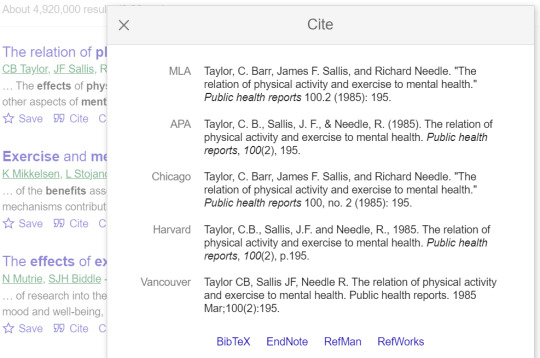
Below are several referencing tools and resources that can be used for different referencing styles in many ways. This includes providing referencing guidance, generating references, and managing your references. The goal is to choose a suitable one that you are comfortable with and familiarise yourself with. There are also YouTube videos on how to use most of them. Cite Me RightMendeleyJabRefCitation MachineCiteFastRefWorksCite This For MeRefMeEndNoteCitaviEasyBibBibMeZoteroPapersZetoroBib
Conclusion
Academic referencing is a very important part of your academic written work. This is because it contributes to the credibility and accuracy of your work. It helps you avoid plagiarism and impacts your grades positively when done right. The further you go in your studies the more important it becomes. Ordinarily, a level five (second year of undergraduate) piece of academic work that includes all the right information and answers the question without citations and references may not pass. However, if all the sources used are cited with a list of references, it will pass with a good grade. So, it is worth investing time in knowing how to cite and reference in your field of study. Learn how to find the sources to use in your assignment here. Read the full article
#HowCanYouUseTheHarvardReferencingStyle?#HowtoAnswerAssignmentQuestion#Howtodoassignment#PopularReferencingStyles#ReferencingToolsandResources#Whatisacademicreferencing?#WhyisAcademicReferencingImportant?
0 notes
Text
What is the Best Way to do my Presentation Assessment?

Introduction
Delivering presentations tops the list of the most nerve-wracking assessments you will do while studying. For a typical student without experience in public speaking, this is a daunting task. Within business and management studies, you can’t avoid having to do a few before you graduate. This is the same for several other fields. To perform well, you want to answer the question; what is the best way to do my presentation? This article will talk you through what you can do at the different stages to deliver a successful presentation. Below are some tried-and-tested presentation ammunitions to stash in your assessment arsenal.
Plan Your Presentation
Not planning for a presentation is like jumping into a deep pool without learning how to swim. You will drown. These are some tips on what to do during planning. Know the Topic The first step is to learn the specific topic-areas that will apply to your presentation. For some presentation assessments, you will have these clearly mentioned. Others may be broadly set around one or more topic areas. In this case, you need to determine the specific areas to focus on. Besides the assignment question, the lecturer can be helpful with this. Once you know the specifics, do your research. Identify and make notes of the main points to focus on. Know the audience Not knowing the audience is a major reason many presentations go wrong. Like the topic, you must research the audience. For assessments, this is straightforward. It’s a lecturer (or a few) and other students. You must know the expectations of the lecturer you are presenting to. This is easy to know. Check the assignment requirements and ask. Knowing the expectations will help you tailor your presentation to the audience. If the presentation is not an assessment, find the interests of the audience when you research them. set smart objectives The main objective will answer the question; what do you want to achieve with the presentation? This is not the grade you want. It is what you have to do to achieve the grade. Another way to determine the objective is by asking what should remain with the audience after the presentation. For clarity, using the SMART technique will help with this. That is, the objective should be specific, measurable, achievable, relevant, and timely. University of Cambridge provides a quick guide of the SMART technique here. Use a Method Besides the overall structure below, you need a clear method for your presentation. The method can be done in several ways. A popular method is telling a story. This is commonly used in Ted Talks. A similar method is using an analogy. A part of the presentation is told as a story, or an analogy and the important elements of the topic are embedded. This helps in two ways. Your delivery is better organised, and you cover the main points. You create or tweak the story during the planning stage. Other methods are visual aids and videos. The images or pictures are used as reminders for the different points. They are also used to get the audience engaged.

Rehearse Your Presentation You have to deliver the presentation several times before the main delivery. Present to yourself using a mirror. Present to your friends or family members. This will help you regulate your timing. You will be able to adjust your tone, body language and pacing before the main presentation. Also, the contents that you either forget or are not comfortable with will become obvious. You can work on them or change them. It may be wording or sentence structures. Rehearsing will get you more confident and comfortable which helps to calm your nerves.
Structure Your Presentation
The structure you use can make or mar your presentation Not having a structure is a no-no. Use a structure that will enable you to deliver the presentation in the best way possible. Your structure should consider important factors such as the assessment requirements and the audience. Below are some tried-and-tested ways to effectively structure your presentation: Attention-grabbing Opener Start your delivery with surprising information that captures the attention of your audience. This is another reason it’s important to know your audience. The attention-grabbing opener can be a surprising story, quote, fact, statistic, or rhetorical question that the audience will think about. The length of the presentation, audience, and topic will determine which one is suitable. Introduction and Main Points After grabbing the attention of the audience, introduce your topic and main points. This will help your audience know what your presentation is about and what to expect. Be clear on the main points of your presentation. Name and number them. The aim is to get the audience to follow each main point at a time. Your structure will also be obvious to them as a result. In some cases, each point can be broken down further. Ensure that you link your main points to what’s relevant to the audience when possible. These will be the assignment requirements for the lecturer in presentation assessments. Visuals, Examples and Evidence Visual aids are the foundation and reinforcement of your delivery. Use them to enhance your delivery. Ensure that the core information is in the visuals. You can add flesh to this when delivering. Your entire audience won’t pay 100% attention to you during the entire presentation. However, your entire audience can pick up the core information from the visual aids. Examples of common visual aids are slides, diagrams, charts, and videos. Ensure that your visual aids are easy to follow, read and understand. Examples and evidence, especially those known to your audience, should be used to reinforce your main points. They will convince your audience more. Evidence can be statistics and other data for presentation assessment. Summary and Conclusion Conclude with a summary of your main points. Ensure to include the key takeaways that you want your audience to remember after. A strong conclusion stays longer with the audience. Like the introduction, an impactful story or quote that captures your presentation works well.
Delivering Your Presentation
Students believe delivering a presentation is the hardest part. It doesn’t have to be. The more research, planning and preparation the easier the delivery. Expect to be nervous during delivery and plan for this. Planning what to do when nervous and practising this gives you more control of your nerves. In addition to rehearsing, these are some ways to effectively deliver your presentation:

Perform it to Make it See the presentation as a performance. Act confident even if you don’t feel confident. Be as authentic as you can. Maintain eye contact as much as you can. If the audience scares you, pick someone in the middle and present to her/him. Occasionally look at someone on your left and another on your right. Use gestures and body language to emphasise your point. This will keep the audience engaged. Remember, you are performing. Avoid speaking fast and pause at intervals, especially after an important point. This will allow your audience to take it in. You can also pause to get the audience to re-focus at the start of an important point. Also, facilitate interaction when possible. This can be done by asking questions and asking for feedback. Presentation Tools There are many tools that you can use for your presentation. If you are a student that doesn’t know how to use these tools don’t worry. Learn on YouTube. There are many videos on how to use each of these presentation tools on YouTube. The most popular presentation tool is Microsoft PowerPoint. If you have a university or college Office 365 email address, it comes with Microsoft PowerPoint. Ensure to choose the tool that is more suitable for your presentation. Other tools are Google Slides, Microsoft Sway, Prezi, Powtoon, and Canva. Skills Developed from Presentation Presentation assessments are important because they enable you to develop very important skills. These skills will be useful in your professional career when you graduate. For example, verbal and non-verbal communication skills from delivering the presentation. Research and time management skills from finding the sources, planning, and prioritising their usage. Critical thinking and problem-solving skills from analysing and evaluating the information found, as well as, dealing with a nerve-wracking situation.
Conclusion
The thought of having to stand in front of the entire class to present can be fearful. It won’t be unwise to avoid it considering the fear. However, when faced with a presentation assessment you normally have only one option. That is to do it, there is no other way out. Presentation assessments are not to be taken lightly when it comes to preparation. This is because presentations can go wrong really quickly. This happens when there’s no preparation. In essence, the most sensible thing to do when you have presentations is to plan and prepare. Planning and preparation help to prevent fear and nerves from affecting the delivery. This contributes to the effectiveness of the presentation, which impacts the grade. The extent to which your presentation is effective is determined by the amount of planning and preparation put in. An effective fifteen-minute presentation assessment would require hours of preparation. Drop your questions (and thoughts) in the comment box below. Read the full article
#DeliveringYourPresentation#PlanningYourPresentation#PresentationTools#RehearseYourPresentation#SetSMARTPresentationObjectives#SkillsDevelopedfromPresentation#StructuringYourPresentation#WhatistheBestWaytodomyPresentationAssessment?
0 notes
Text
Why is Reflective Learning important?

Introduction
At some point in your study journey, you will definitely hear about the importance of reflective learning. Why is reflective learning important though? This article will inform you of its importance in many ways. Not reflecting on the learning experiences at university is like buying a cake and eating the icing only. What is reflective learning to start with? Reflective learning is the conscious process of thinking analytically about your learning experiences. The purpose is to gain a deeper understanding so that you can improve in the future. This involves taking time to think about what you learnt and how you learnt it. It includes thinking about why you learnt it the way you did. In addition to study-related learning, reflective learning helps to develop continuously in professional and personal contexts.
Reflective Learning vs Reflective Writing
Although reflective learning helps in reflective writing and vice versa, they are different from each other. Unlike reflective learning which involves thinking about experiences to improve, reflective writing is writing down the thoughts. This is best done for each specific experience using a structure. Reflective writing is one of the different ways to intentionally engage in reflective learning.
Types of Reflective Learning
Reflective learning can occur in many ways. The following are some popular ways you can learn reflectively as a student: Experiential Reflection This is when you learn from hands-on experiences. Some experiences can be delivering presentations or organising events as a student. Other experiences include doing internships, volunteering, and work experiences. There are at least three core areas to identify from hands-on experiences. These are what was learnt, how they were learnt and how they can be used in the future. Peer Reflection Here, you reflect with others who may have had similar experiences. They don’t have to have had similar experiences though. Others can be course-mates, colleagues, friends, and family members. The aim is to gain new insights from different points of view, learn from others' experiences and get feedback. Critical Reflection For critical reflection, you are intentionally critical and analytical when thinking about experiences. This way, you can be clear on biases and non-factual assumptions. Also, you can evaluate your learning and look at different perspectives. Self Reflection The emphasis here is learning from your own individual experience of something. This includes your views and feelings about something, which can be different from that of others. Examples are workshops, lectures, or assessments. The three core things to identify here are your strengths, weaknesses and plans to improve.

Group Reflection This involves reflecting on shared experiences with the group members involved. Examples of shared experiences are group presentations and team projects. This helps to learn from different perspectives and to share understanding.
Benefits of Reflective Learning
In addition to personal development, these are some other benefits of reflective learning: Avoid Mistakes Reflecting on what went wrong, how, and why after an experience would help you avoid future mistakes. This is because you will remember the actions or behaviours that led to the previous mistake and avoid them. Also, you can become more resilient by bouncing back after mistakes. More Self-awareness Reflecting on your experiences, thoughts and feelings helps you understand yourself deeper. It gives you clarity on why you do the things you do, as well as how you do them. You become more aware of your strengths and the areas to improve on. With better self-awareness, you can make well-informed decisions on your studies and other areas of life.

Better Relationships Without reflecting, some behaviours that may not go well with others can be overlooked. Worse still, you can be genuinely unaware of them when they happen. However, reflecting on your interactions with others can make these behaviours obvious. This will help work on them to develop better relationships. Better Goal-setting Reflection gives you clarity on what your aspirations and interests are as a student. Being clear about these would enable you to set goals that align with them. Your goals will determine your overall behaviour. Critical Thinking Frequent reflections train your mind to become more analytical and critical. Besides experiences, you can evaluate concepts and theories better. This is by identifying different perspectives and possible biases, as well as considering alternatives like you do when reflecting. You can also become more creative by generating new insights.
Practical Ways to Reflect on Learning
Many different techniques and approaches can be used to reflect on learning. These are some practical ways to reflect on learning: Note Taking Let’s face it we are human, and we can’t always remember everything. Writing down your thoughts, feelings and experiences will ensure you have the necessary information to reflect on. For students, notes can be on the core elements of a lesson or a concept. Follow the lecturer's lead to identify core elements. Notes can also be on key information during discussions or from verbal feedback. Reflecting on incorrect information can be misleading. This is why it’s also important to take notes. You can use the same structure for your notes and reflective writing. Reflective Models There are many reflective models that you can use to structure your reflection. The goal is to choose the one that works well for you and stick with it. Some of the models have similar structures. This means that you can use more than one in the same way. Some examples from the University of Edinburgh and University of Hull are Kolb's Cycle of Reflective Practice, Gibb’s Reflective Cycle, CARL's Framework of Reflection, Driscoll’s Model of Reflection, The Four F's of Active Reviewing, The 5R Framework for Reflection, and The Integrated Reflective Cycle. Reflective Prompts and Visuals Reflective prompts are questions that will provide reflective answers on specific experiences or topics. The University of Edinburgh provides many reflective prompts for each part of the reflective models above. These questions would help guide your reflective writing in the right direction. This way, you can take the best learning out of the experience reflected. With visualisation, vivid images are used to replace different parts of an experience. Images can represent what you intended to avoid in the future. Alternatively, they can represent what you want to achieve from a similar experience.
Conclusion
The ease and subtlety of reflection make it seem ineffective. However, it is significantly effective and can be a powerful ability when done consistently. The power of reflection is in the extent of consistency. Also, effective reflection can’t be unintentional or unsystematic. To be very effective, you have to intentionally reflect consistently using a structure. Let’s look at it this way. Imagine reflecting on the core parts of every lecture, workshop, tutorial, and study session in a term. Then, do the same for every activity, test, assignment, and exam. Multiply it by nine. By the time you graduate, you would have learnt so much your brain will be a moving box of knowledge in your field. Learn how to use the learning acquired during exams here. Drop your questions (and thoughts) in the comment box below. Read the full article
#BenefitsofReflectiveLearning#CARL'sFrameworkofReflection#Driscoll’sModelofReflection#Gibb'sreflectivecycle#Kolb'sCycleofReflectivePractice#PracticalWaystoReflectonLearning#ReflectiveLearningvsReflectiveWriting#ReflectiveModels#The5RFrameworkforReflection#TheFourF'sofActiveReviewing#TheIntegratedReflectiveCycle#Typesofreflectivelearning#WhyisReflectiveLearningimportant?
0 notes
Text
Why is it Important to do Assignments?

Introduction Have you ever asked yourself, why is it important to do assignments while studying? Or, why do I have to go through the stress of doing an assignment all the time? As you already know, assignments are a core part of studying. This is because they help enhance the learning that students get out of their studies. Whilst the academic importance of doing assignments is emphasised, the non-academic benefits are underrated. This article will inform you of the academic and non-academic benefits of doing assignments. The non-academic benefits will be categorised under transferable skills and good characteristics. After going through this article, you can see the big picture beyond the academic benefits when faced with an assignment in the future. Academic Benefits Of Doing Assignments The course or topic-related knowledge gained and enhanced by doing each assignment is important. This helps develop you into an expert in your field of study. You are also exposed to the core and emerging issues faced in the field. Acquiring topic-related knowledge and being exposed to issues in the field through assignments come with academic benefits too. Some of these benefits are below: Critical Thinking The requirements of assignments, especially at level four and beyond, don’t allow straightforward thinking. Instead, you have to think critically and analyse the information you find to effectively answer the assignment question. The critical and analytical skills you develop in the process will be applicable to many fields. Especially, in fields that involve dealing with people, which are most fields really. Enhance Understanding To be able to apply the concepts and theories learnt effectively, you need to understand them properly. Using concepts and theories in an assignment helps you gain a deeper understanding beyond classroom learning. You can then apply them in more contexts beyond what’s studied. This also helps you build confidence about the specific module and subsequent ones.

Exam Preparation In modules where you have assignments and exams, assignment is a good opportunity to practice. The concepts and theories that will be used to answer exam questions are first practised while doing an assignment. This is in addition to gaining more knowledge about the subject or topics. Being knowledgeable about the topics and practising them help reduce exam anxiety. This allows the focus and clarity you need whilst answering exam questions. Feedback Assignments provide the opportunity to get improvement feedback. Feedback will be on topic-specific issues and general study skills that will enhance your abilities when put into practice. Also, feedback will help you identify your strengths and weaknesses that were not obvious to you before. This allows you to take advantage of your strengths and improve on your weaknesses. Transferable Skills Acquired from Doing Assignments You may know someone who studied a specific course and went into a very different field. For example, someone who studied psychology but works in finance. This is not surprising because the transferrable skills you acquire while studying can be used in many fields. What’s important is to hone these skills as much as possible while studying. Assignments provide a good opportunity for this. There are many transferable skills that can be acquired from assignments. This part will focus on some popular ones.

Organisational Skills Assignments are projects, which can be small or big, that require you to organise the different parts to come up with an answer. These parts include identifying the specific assignment requirements for each assignment. Others are organising how to start each assignment, what the different parts should include, etc. Also, the deadline set for the assignment requires you to set a time frame for the different parts. See each assignment as an opportunity to practice these skills. Being organised and managing your time well will enable you to do your assignment effectively. This will impact your grade positively. Having excellent organisational and time management skills will enable you to stand out in most job roles. Research Skills A well-done assignment requires good research. Having determined what the different parts should include from the question, you need to find materials on them. Doing research to find the right sources to use in each assignment will help you develop research skills. In most professional jobs, the ability to be able to independently find, locate and use the information found to solve problems is highly sorted after. Use the opportunity provided by all that assignments to learn and hone your research skills. You will need them to shine in that amazing job you are aiming for. Writing Skills It is one thing to find the right information, but another to communicate it in the best way possible. Or at least, as you intend to without confusing the reader. Better still, to make the impact you desired. How best to learn this than from having to write one assignment after the other? Each assignment is an opportunity to make your written communication clearer. When it comes to written communication, clarity is king. Also, the ideas in your written communication have to be organised and presented in a logical way. Coherence is also important. Doing one assignment after the other is an opportunity to practice these skills. Interpersonal Skills It is possible to have gone through life before university without having to work on something important with strangers. You may have worked on important things with friends and family members. However, group assignments at the university will get you to work on something that is as important as your grade with strangers. Group assignments will help you develop the interpersonal skills required to work with people that are different from you in several ways. You will learn to collaborate, exchange ideas, and create something with them despite their differences. It may be better to avoid them altogether but you can’t in most cases. You have to find a way to work with them to get the assignment done. This is sometimes the case in a work environment. You will have colleagues that are very different from you and some that you find annoying, or strange. However you find them, you still have to work will them anyways. Group assignments prepare you for this. Good Characteristics Developed from Doing Assignments The characters developed from going through university, which includes doing assignments, are underrated. For some people, if not most, the character developed at university will take them further than the qualification. Doing one assignment after another helps to develop those good characters that don’t have shortcuts to develop. They take a long and sometimes challenging process to develop. This part is on some of the good characteristics that you develop from doing assignments. Resilience and Perseverance Answering assignment questions will present challenges that require resilience to overcome them. These challenges include being unable to understand the concepts, theories and what the questions require. Others are not knowing how to use the concepts for the assignment and the difficulty in finding the right sources to use. The inability to write academically, achieve the word count or meet the deadlines considering other responsibilities can be challenging too. In addition to the endless list of challenges, the fear of failing the assignment if it’s not done properly make things worse. Taking on these challenges, instead of giving up, and doing all you can makes you more resilient. Having to do this over and over again, assignment after assignment will build your persistence in the face of challenges. Being resilient and persistent will enable you to take on a lot of life challenges after you graduate. Respect and Discipline It takes self-discipline to take on an assignment and submit it by the deadline. Having to do this for every assignment means being goal-oriented, consistently avoiding distractions and remaining focused. This enhances your self-discipline abilities in ways that will enable you to make a difference in many fields and areas of life. Collaborating with others to complete assignments means that you have to respect their ideas, opinions, manners and so on. Being able to do this makes you gain the respect of others too. Overall, part of the respect you get from being a graduate is what your qualification says. That is, you have been there, done it, which includes the assignments, and come out more knowledgeable.

Responsibility and Integrity Students are entirely responsible for completing their assignments. Being able to do your assignment and submit it by the deadline makes you responsible. Having to deliver in this way for every assignment will make you a more accountable and dependable person. Doing your assignments in the right way without being monitored takes honesty and integrity. Having to do every assignment in the right way without cheating or plagiarising, despite the many challenges, and submitting by the deadline makes you more responsible with commendable integrity. These traits make you stand out at work and in life. People know when you have these traits, and it positively impacts how they interact with you. Conclusion These skills, abilities and characteristics are best learnt when you are intentional about them. See each assignment as an opportunity to acquire and enhance them, not as a problem. Also, It is easy to go through university without consciously knowing that you have developed these skills, abilities and characteristics. I can assure you that if you have studied for a certification or a degree you are likely to have developed them. It can be challenging to communicate how you have developed them if need be. Reflecting on how you have acquired them during and after each module is a sure way to do this. However, ensure that you have a reflective journal to document them. This is important because your course will take a while and you are likely going to forget some if you don’t document them. Documenting them will help you prepare for interviews effectively. This is by using these skills and abilities you have acquired to show how you meet the job requirements. Drop your questions (and thoughts) in the comment box below. Read the full article
#Howcanyoulearnfromassignments?#Howdoassignmentshelpstudents?#Importanceofdoingassignment#Whydostudentsneedtodoassignments?#Whyisitimportanttodoassignmentswhenstudying?#WhyisitImportanttodoAssignments?
0 notes
Text
Why is it Important to do Assignments?

Introduction Have you ever asked yourself, why is it important to do assignments while studying? Or, why do I have to go through the stress of doing an assignment all the time? As you already know, assignments are a core part of studying. This is because they help enhance the learning that students get out of their studies. Whilst the academic importance of doing assignments is emphasised, the non-academic benefits are underrated. This article will inform you of the academic and non-academic benefits of doing assignments. The non-academic benefits will be categorised under transferable skills and good characteristics. After going through this article, you can see the big picture beyond the academic benefits when faced with an assignment in the future. Academic Benefits Of Doing Assignments The course or topic-related knowledge gained and enhanced by doing each assignment is important. This helps develop you into an expert in your field of study. You are also exposed to the core and emerging issues faced in the field. Acquiring topic-related knowledge and being exposed to issues in the field through assignments come with academic benefits too. Some of these benefits are below: Critical Thinking The requirements of assignments, especially at level four and beyond, don’t allow straightforward thinking. Instead, you have to think critically and analyse the information you find to effectively answer the assignment question. The critical and analytical skills you develop in the process will be applicable to many fields. Especially, in fields that involve dealing with people, which are most fields really. Enhance Understanding To be able to apply the concepts and theories learnt effectively, you need to understand them properly. Using concepts and theories in an assignment helps you gain a deeper understanding beyond classroom learning. You can then apply them in more contexts beyond what’s studied. This also helps you build confidence about the specific module and subsequent ones.

Exam Preparation In modules where you have assignments and exams, assignment is a good opportunity to practice. The concepts and theories that will be used to answer exam questions are first practised while doing an assignment. This is in addition to gaining more knowledge about the subject or topics. Being knowledgeable about the topics and practising them help reduce exam anxiety. This allows the focus and clarity you need whilst answering exam questions. Feedback Assignments provide the opportunity to get improvement feedback. Feedback will be on topic-specific issues and general study skills that will enhance your abilities when put into practice. Also, feedback will help you identify your strengths and weaknesses that were not obvious to you before. This allows you to take advantage of your strengths and improve on your weaknesses. Transferable Skills Acquired from Doing Assignments You may know someone who studied a specific course and went into a very different field. For example, someone who studied psychology but works in finance. This is not surprising because the transferrable skills you acquire while studying can be used in many fields. What’s important is to hone these skills as much as possible while studying. Assignments provide a good opportunity for this. There are many transferable skills that can be acquired from assignments. This part will focus on some popular ones.

Organisational Skills Assignments are projects, which can be small or big, that require you to organise the different parts to come up with an answer. These parts include identifying the specific assignment requirements for each assignment. Others are organising how to start each assignment, what the different parts should include, etc. Also, the deadline set for the assignment requires you to set a time frame for the different parts. See each assignment as an opportunity to practice these skills. Being organised and managing your time well will enable you to do your assignment effectively. This will impact your grade positively. Having excellent organisational and time management skills will enable you to stand out in most job roles. Research Skills A well-done assignment requires good research. Having determined what the different parts should include from the question, you need to find materials on them. Doing research to find the right sources to use in each assignment will help you develop research skills. In most professional jobs, the ability to be able to independently find, locate and use the information found to solve problems is highly sorted after. Use the opportunity provided by all that assignments to learn and hone your research skills. You will need them to shine in that amazing job you are aiming for. Writing Skills It is one thing to find the right information, but another to communicate it in the best way possible. Or at least, as you intend to without confusing the reader. Better still, to make the impact you desired. How best to learn this than from having to write one assignment after the other? Each assignment is an opportunity to make your written communication clearer. When it comes to written communication, clarity is king. Also, the ideas in your written communication have to be organised and presented in a logical way. Coherence is also important. Doing one assignment after the other is an opportunity to practice these skills. Interpersonal Skills It is possible to have gone through life before university without having to work on something important with strangers. You may have worked on important things with friends and family members. However, group assignments at the university will get you to work on something that is as important as your grade with strangers. Group assignments will help you develop the interpersonal skills required to work with people that are different from you in several ways. You will learn to collaborate, exchange ideas, and create something with them despite their differences. It may be better to avoid them altogether but you can’t in most cases. You have to find a way to work with them to get the assignment done. This is sometimes the case in a work environment. You will have colleagues that are very different from you and some that you find annoying, or strange. However you find them, you still have to work will them anyways. Group assignments prepare you for this. Good Characteristics Developed from Doing Assignments The characters developed from going through university, which includes doing assignments, are underrated. For some people, if not most, the character developed at university will take them further than the qualification. Doing one assignment after another helps to develop those good characters that don’t have shortcuts to develop. They take a long and sometimes challenging process to develop. This part is on some of the good characteristics that you develop from doing assignments. Resilience and Perseverance Answering assignment questions will present challenges that require resilience to overcome them. These challenges include being unable to understand the concepts, theories and what the questions require. Others are not knowing how to use the concepts for the assignment and the difficulty in finding the right sources to use. The inability to write academically, achieve the word count or meet the deadlines considering other responsibilities can be challenging too. In addition to the endless list of challenges, the fear of failing the assignment if it’s not done properly make things worse. Taking on these challenges, instead of giving up, and doing all you can makes you more resilient. Having to do this over and over again, assignment after assignment will build your persistence in the face of challenges. Being resilient and persistent will enable you to take on a lot of life challenges after you graduate. Respect and Discipline It takes self-discipline to take on an assignment and submit it by the deadline. Having to do this for every assignment means being goal-oriented, consistently avoiding distractions and remaining focused. This enhances your self-discipline abilities in ways that will enable you to make a difference in many fields and areas of life. Collaborating with others to complete assignments means that you have to respect their ideas, opinions, manners and so on. Being able to do this makes you gain the respect of others too. Overall, part of the respect you get from being a graduate is what your qualification says. That is, you have been there, done it, which includes the assignments, and come out more knowledgeable.

Responsibility and Integrity Students are entirely responsible for completing their assignments. Being able to do your assignment and submit it by the deadline makes you responsible. Having to deliver in this way for every assignment will make you a more accountable and dependable person. Doing your assignments in the right way without being monitored takes honesty and integrity. Having to do every assignment in the right way without cheating or plagiarising, despite the many challenges, and submitting by the deadline makes you more responsible with commendable integrity. These traits make you stand out at work and in life. People know when you have these traits, and it positively impacts how they interact with you. Conclusion These skills, abilities and characteristics are best learnt when you are intentional about them. See each assignment as an opportunity to acquire and enhance them, not as a problem. Also, It is easy to go through university without consciously knowing that you have developed these skills, abilities and characteristics. I can assure you that if you have studied for a certification or a degree you are likely to have developed them. It can be challenging to communicate how you have developed them if need be. Reflecting on how you have acquired them during and after each module is a sure way to do this. However, ensure that you have a reflective journal to document them. This is important because your course will take a while and you are likely going to forget some if you don’t document them. Documenting them will help you prepare for interviews effectively. This is by using these skills and abilities you have acquired to show how you meet the job requirements. Drop your questions (and thoughts) in the comment box below. Read the full article
#Howcanyoulearnfromassignments?#Howdoassignmentshelpstudents?#Importanceofdoingassignment#Whydostudentsneedtodoassignments?#Whyisitimportanttodoassignmentswhenstudying?#WhyisitImportanttodoAssignments?
0 notes
Text
Can I Use ChatGPT to do My Assignment?

Introduction A burning question among students is “can I use ChatGPT to do my assignment?”. The answer depends on the intention behind the question. Is the intention to use ChatGPT to actually produce the assignment? Or the intention is to use ChatGPT for support while doing the assignment? ChatGPT, like other artificial intelligence (AI) tools, can be a force for good in education. Sadly, like many good things, they can be used wrongly. The issue is not ChatGPT but how it is used. This article will cover how ChatGPT and other AI tools can be used acceptably for assignments. Also, unacceptable usage of these AI tools for assignment is looked at. What is ChatGPT? ChatGPT is a large language AI model developed by OpenAI. The AI is created to generate human-like responses to natural language queries using different language-based tasks. Some of these tasks are translation, conversation, and summarising. ChatGPT uses texts available on the internet to create an appropriate response to a wide range of queries. There are three versions: GPT-3, GPT-3.5, and GPT-4. Acceptable Ways to Use ChatGPT for Assignment There are some generally acceptable ways in which you can use AI tools for your assignment. The same goes for ChatGPT. Research Aid: You can use AI tools to search for relevant sources and information to back the perspectives and arguments in your assignment. This is a good way to find information quickly and efficiently. The sources you find are then used and cited in your assignment. Learn how to effectively use sources in your assignment here. Proofreading: AI tools can be very helpful when it comes to editing or proofreading your assignment. They identify errors that are easy to miss and make suggestions for improvements. The overall quality of your assignment can be enhanced this way.

Grammar Support: You can use AI tools to check the grammar and spelling of your assignment. An example is Grammarly. Using these tools can help you improve the quality of your writing with fewer errors. Check more ways that ChatGPT can be used in this Harvard Business School article. Other Usage: Besides these generally acceptable usages, there may be more specific usage that your lecturer, course or university allows. Ensure to find out. For example, using ChatGPT to generate general ideas that research is then done on may be one. Another may be to assess critical thinking by having students analyse and compare content produced by AI with that of a human. Unacceptable Ways to Use ChatGPT for Assignment There are some clearly unacceptable ways when it comes to using AI tools or ChatGPT for assignments.

Deception: The use of AI or ChatGPT to create the impression that an assignment was originally created by a student when it wasn’t is deceptive. In this case, the assignment may have been created by other means. This can lead to serious consequences, some of which are mentioned above. Terms and Conditions: Some AI tools, including ChatGPT, come with terms and conditions that prohibit using them for assignments and exams. They do not allow usages that violate academic integrity policies. There are legal consequences when they are used in ways that violate their terms and conditions. Plagiarism: It is not allowed to use AI or ChatGPT to generate your entire assignment or parts of it. Doing this amount to plagiarism which violates the academic integrity policies of most institutions. This will result in serious consequences such as failing the assignment, the course, or even expulsion from the university. However, in an unusual situation when an assignment requires that you produce work using AI, maybe to test your AI proficiency, the instructor will make this clear. In this case, there should be proper citations to avoid plagiarism. Conclusion Although ChatGPT and other AI tools can be helpful when doing your assignment, they should only be used to enhance your assignment in acceptable ways. They cannot be used to replace your own ideas, views, perspectives and writing. Where you use them, ensure to check with your lecturer or student services office to be sure following the rules. Finally, it is best practice to use ChatGPT and other AI tools responsibly and ethically. Learn how the sources you find via AI tools can be used like a lecturer in your assignment. Drop your questions (and thoughts) in the comment box below. Read the full article
#AItodoassignment#ArtificialIntelligenceforassignment#CanIUseChatGPTtodoMyAssignment?#ChatGPTforassessment#HowtoAnswerAssignmentQuestion#Howtodoassignment
0 notes
Text
Report Assignment vs Essay Assignment: What’s the Difference?

Introduction Report assignments and essay assignments are both common types of assessments that you may encounter while studying. Although they have some similarities, there are key differences between them. It is important to know these key differences because doing one instead of the other will affect your grade. The easiest way to find out the required one is from the assignment brief or question. It will either mention an essay or a report. Some of the key differences are the structure, purpose and presentation. This article will show you the general differences so that you don’t mistakenly do one instead of the other when asked. For specific requirements, the assignment brief or lecturer is your best bet. Check out level-specific assignment requirements here. The Purpose of a Report A report assignment provides information about a specific topic or issue. This is normally broken down into the key elements that apply to the assignment question. Sometimes, because of the report assignment question, only specific parts of the topic are required. The goal of an assignment report is to inform an audience. Even though the marker knows about the topic, the report should be written as though he doesn’t. The Purpose of an Essay Because the purpose of an essay assignment varies, ensure that you are clear about it from the brief or lecturer. In general, an essay expresses a viewpoint or an argument. Some essays would require you to explore a topic in-depth and interpret information. However, an essay assignment in business and management studies can be quite different from that of other areas such as journalism and psychology. More details below. Language Differences Within business and management studies, the language of both can be similar. This is because the same academic writing style is required for both. This is not the same in all areas of study. Your lecturer or instructor will inform you when you ask. In general, reports are typically written in a more formal and objective style, with a focus on presenting factual information. Essays can allow some subjectivity such as personal opinions or perspectives. However, this depends on a number of factors which include the field of study, the assignment question, the location of study and the level. Some essays within business and management studies do not allow subjectivity. They are written in an objective academic style. Essay Assignment Structure An essay assignment typically has a basic structure that includes an introduction, body paragraphs, and a conclusion. The specific format of an essay assignment may vary depending on the lecturer’s guidelines or the requirements of the assignment. The following is a general structure of a typical essay assignment: Essay Introduction: The introduction is the first paragraph of the essay. It should include an attention-grabbing opening statement, background information about the topic, and a statement that outlines the main argument or point of the essay. Body Paragraphs: The body paragraphs make up the main section of the essay. They should provide supporting evidence to back up the main statement. Each body paragraph should have a clear topic sentence, supporting evidence or examples, and a concluding sentence that links back to the thesis statement. Use the PEA (point, evidence, analysis) technique to efficiently structure your paragraphs.

Essay Conclusion: The conclusion is the final paragraph of the essay. It should summarise the main points of the essay and restate the main statement in a new way. Also, it should provide a closing statement that leaves a lasting impression on the reader. report Assignment Structure Specifically, the assignment requirements and lecturer’s guidelines will tell you the expected structure. Reports are structured with headings and subheadings to organize information in a clear and logical way. Generally, a report assignment structure will include the following sections: Title Page: The title page should include the title of the report, the name of the author or authors, the date, and any other relevant information such as the name of the department or institution. Table of Contents: The table of contents lists the major sections, subsections, and the corresponding page numbers of the report. Executive Summary: The executive summary is a brief overview of the main findings and conclusions of the report. It should be concise and provide an overview of the entire report. Abstract: In some reports, especially research articles and dissertations, an abstract is included. It concisely summarises the entire work. This includes the purpose of the research, the methods used, the findings and the conclusions.

Introduction: The introduction provides background information on the topic of the report. This includes any relevant history or context. It should also include the purpose of the report and the scope of the research. Methodology: The methodology section explains the methods used to gather data and conduct research. This section may include details on the sample size, data collection tools and techniques, and data analysis methods. Some reports do not require a methodology section due to the report requirements. In others, this is embedded within the discussion section. Results: The results section presents the findings of the research in a clear and organised way. This section may include tables, graphs, and other visual aids to help illustrate the data. In some reports, the results and visual aids are embedded in the discussion. Discussion: The discussion section provides an analysis and interpretation of the results. This section should explain the significance of the findings and relate them back to the purpose of the report. Conclusion: Here, the main findings and conclusions of the report are summarised. It should also include any recommendations for future action or research. References: The references section lists all sources cited in the report, including books, articles, and other materials. Bibliography: Where other sources have been read but not cited in the report, a bibliography is ideal. This is because it includes the sources that are not cited to the ones cited. Appendices: The appendices section includes any additional information that supports the report, such as raw data, surveys, or detailed calculations. Conclusion Using the right structure suitable for the assignment question shows a good understanding of what’s required. It also contributes to the grade because of the professional presentation requirement in business and management assignments. However, using the wrong structure shows a lack of understanding which may affect the grade. Ultimately, carefully review the assignment instructions and follow any specific guidelines provided by the lecturer. This is because the requirements for reports and essays are sometimes different from the norm. This is how you think like a Lecturer when doing your assignments. Drop your questions (and thoughts) in the comment box below. Read the full article
#AssignmentPlanning#AssignmentStructure#EssayStructure#HowisReportAssignmentdifferentfromEssayAssignment?#ReportAssignmentvsEssayAssignment#ReportStructure
0 notes
Text
Are Assignment Writing Services Legal?

Introduction Assignment writing services are becoming popular. You see them spring up in every corner in places where there are colleges and universities. Sometimes even within universities. They are so common that some students can be forgiven for assuming that they are the norm. However, they are not the norm. It is a recent phenomenon that has been exacerbated by several issues. Some of which are an increase in remote courses and assessments due to the Covid-19 Pandemic and online tutoring agencies. The million dollar question is: Are Assignment Writing Services Legal? Assignment Writing Services are mostly Illegal. You will see how below. They can be legal if they operate within the bounds of the law and do not engage in fraudulent or unethical practices. These organisations can aid students who require help with their assignments, such as editing, proofreading, or researching. However, colleges and universities provide these services already. Students do not need to pay external organisations that may not help as much as their institution. Colleges and universities provide more tailored assistance suitable for specific courses, modules, and levels of study. Is Paying for Assignment Services Legal? No. It is illegal to pay others to do your university assignment for you. Academic institutions have strict policies and regulations that govern plagiarism and academic integrity. Submitting work that has been written by someone else is considered academic dishonesty. Universities and colleges consider such actions to be a serious offence. They take disciplinary actions against students for academic dishonesty. These actions include failing the assignment, the course, or even expulsion from the institution. Also, paying someone to write your assignment is considered a violation of the student terms and conditions of all legitimate academic institutions. Do not pay others to do your assignments because it can have serious consequences which may ultimately harm your academic career. How about Assignment Writing Organisations? If an organisation charges you a fee to help do your assignment, that organisation is a criminal organisation. Such an organisation may be connected to an organised crime syndicate. The same goes for individuals posing as assignment writing experts. They are criminals. Getting involved with them exposes you to the consequences that come with criminal activities. Some of these consequences are blackmailing, extortion, bribery, exploitation, sexual abuse, and murder. Getting involved with such organisations or individuals may prevent you from graduating if you get out alive. Knowingly getting involved with them makes you a criminal. The Right Student Mindset Students must complete their assessments themselves without any alternative. This should be your mindset before you start studying. When you have this mindset, you will be open to seeking help from instructors or academic support services when you need assistance. Studying can be overwhelming and assessments make it even worse. Facing such challenges and overcoming them is a part of learning. You learn more than the contents of the course you are studying. Going through study challenges builds your character so much that you can face a lot more than you could before you started studying.

The character developed will take you further than your qualification. Don’t lose out. Go through the process and come out better. When you stand on that podium for your graduation, you can proudly say “I did it!". What's The Law on Assignment writing Services? The law is clear that it is illegal to pay someone to do a university assignment for you. This is because it constitutes academic fraud and dishonesty, which are prohibited by law. In many countries, such as the United States and the United Kingdom, academic fraud is a criminal offence, and individuals who engage in such activities can face legal consequences, including fines and imprisonment. The laws that prohibit academic fraud and offences vary depending on the country and jurisdiction. In general, academic fraud is considered a form of intellectual property theft and falls under the umbrella of fraud and deception. In the United States, for example, academic fraud is prohibited by federal and state laws, including the False Claims Act and the Higher Education Act. The False Claims Act imposes penalties on individuals who knowingly submit false or fraudulent claims to the government, which includes submitting fraudulent academic credentials. Also, the Higher Education Act prohibits the use of federal funds for fraudulent or deceptive practices, including academic fraud. In the United Kingdom, academic fraud is considered a form of misconduct under the UK Quality Code for Higher Education, which outlines the expectations and requirements for higher education institutions in the UK. The Code states that academic misconduct can include plagiarism, collusion, and the use of paid services to complete academic work. Other countries have similar laws and regulations in place to prevent academic fraud and offences. Many universities and colleges also have specific policies and regulations that prohibit such activities. See examples from Harvard University and University of Cambridge. Conclusion In summary, the laws that prohibit academic fraud and offences vary depending on the country and jurisdiction. In general, academic fraud is considered a serious offence and can result in legal and academic consequences. Paying an individual or organisation to do your assignment for you is not only unethical, but illegal, and can have serious consequences both academically, legally, emotionally, financially, mentally, and physically. Don’t do it. Its not worth it. You are Better than that. StudySkills Uni is here to support you every step of the way whilst studying. There are articles on proven techniques that will help you do your assessments effectively on https://studyskillsuni.com/ You can learn what’s required at your level of study here. To break down your assignment answers successfully based on the questions check this article. This one is for tried-and-tested exam preparation techniques. Having prepared for your exam, use this one to write your exam like a pro. For effective ways to start your assignment click here. To find out the right content that will help you smash your assignment use this one here. Drop your questions (and thoughts) in the comment box below. Read the full article
#AreAssignmentWritingServicesLegal?#Isitlegaltouseassignmentwritingservices?#IsPayingforYourAssignmentLegal?
0 notes
Text
How to Answer Essay Exam Questions

Introduction Exams wield supernatural wands to invoke anxiety, stress, fear, nervousness, and other nasty emotions. But it doesn’t have to be this way for you. You can exam-proof yourself and go on to smash every exam that crosses your path. But how is this possible? Ride along and learn how to in this article. For starters, it is very important to know the specific type of exam you will be taking each time. Some exams will have a mixture of different types. Also, it is very helpful to know if the exam is open-book or closed-book. In an open-book exam, you are allowed to use materials such as notes and books when answering. This is not allowed in closed-book exams. Some popular types of exam questions are essay-type, multiple-choice, and problem-solving questions. This article will give you the ammunition to invade any essay exam question and slay it like the terminator. What do Essay Exam Questions Want? In essay exams, do not start writing your answers as soon as the exam time starts. The questions in essay exams do not normally require you to re-write the key content studied in the module from memory. They want you to apply them in the new way that the question requires. To effectively do this, you have to plan your approach and answers. If you already know the structure of the exam and answered past questions during preparation, then you probably already have an approach. Learn how to effectively prepare for exams here. Knowing the structure of the exam during preparation gives you time to plan your answers. Ideally, ten per cent of the exam time should be spent on planning all the answers. Plan Your Answers Planning your exam answers helps you achieve better grades for the following reasons. It allows you to make notes of the main ideas such as concepts, theories, and perspectives around each exam question. Ensure that your notes are at the back of the exam paper and crossed out. Making notes is very important for several reasons. You don’t have to spend time trying to remember the main ideas when you apply them. Because you focused on answering the first exam questions, you may forget the main ideas about the others when you finish. Also, you can forget when anxious or excited once you start writing. The notes will be readily available to help start the second answer. Another reason is that you don’t have to waste time thinking about how to do the next answer after answering the first. You already have notes of what to apply. Also, while writing, other ideas that do not apply to the question you are answering can come to mind. You can then include the ideas in the suitable part of the notes you made for each question. Structure Your Answers After making notes for each question when planning, you can then start writing your answers. However, you also need a structure to answer each question. Having a structure that you follow when answering exam questions is something you can’t overlook. This is even more important if you are studying for an undergraduate degree with an exam in each module. By the time you graduate, you would have ended up doing around fifteen exams or more. This is a lot of exams to do without a structure to tackle each one. Also, the standard of an exam answer can be positively impacted by a good structure. Luckily, there are some useful structures to practice with and stick to. The structure you use will also depend on your level of study. Some examples are PEE (point, evidence, explain), PEA (point, evidence, analysis) PEAE (point, evidence, analysis, evaluate). Whilst PEE may work for level four (first year of undergraduate studies), PEA will be more suitable for level five and PEAE for level six. However, the command words in the exam question should be followed. These structures (PEE, PEA, PEAE) should be applied in each paragraph when answering essay questions. PEAE (Point, Evidence, Analysis, Evaluate) Point: The point should be a direct response to the question you are answering. You can use keywords or a phrase from the question here. The point can also be your broad answer to the question with details to follow. Starting with a point that focuses on the exam question helps you to stick to the topic area within the paragraph. Evidence: These can be the findings, data, or perspectives you studied in the module or beyond that supports your point. However, evidence shouldn’t be limited to these. The type of question and response pointed out would also determine suitable evidence. Examples and analogies can also be used in the evidence part. Whichever type of evidence you use, ensure that you relate it back to the question. The evidence to use for each concept, theory, perspective and sometimes a theme can be planned during exam preparation. Learn effective exam preparation techniques here. Analysis and Evaluation: The technique used to analyse in a written assignment can also be used in an exam. The most important part is developing the technique prior to the exam. In modules where you have to do an assignment before the exam, the stages of analysis may have been used for different concepts in the assignment. The same approach can be used in the exam. Evaluation can be developed from the analysis. Learn how to analyse and evaluate here. Bonus Tips If you completely forget what you know midway through answering, don’t panic. The notes you made as part of your plan will come in handy here. Alternatively, you can read your answer to the question from the start and think about what should come next. If this doesn’t work, leave some space and move on to the next question. You will likely remember later and come back to it. Some students prefer to start with the questions that they know the most about and move on in that order. Others prefer to get the less known ones out of the way before focusing on the most known ones. This is a matter of preference, ensure to do what works well for you. Too much coffee, tea or energy drinks before the exam can be detrimental to your performance. Play it safe and eat healthy food, rest well and sleep early the night before. Divide the exam time and allocate some for planning and spread the rest amongst each question. Conclusion How well you plan and structure your exam answers using the suggestions above can significantly improve your grades. However, this depends on the studying and planning done prior to the exam. In essence, all three elements work together for a successful exam and good grades. That is, studying, preparing for the exam and putting these suggestions into practice during the exam. You don’t have to be an expert at doing this in your first exam. Nobody is. What you can do though is practice, practice and some more practice. You practice them whilst preparing for the exam. You put them into practice whilst doing the exam. You repeat the same in the next exam and so on. Before you know it, you are smashing one exam after the other like a genius! Drop your questions (and thoughts) in the comment box below. Read the full article
#CommandWords#HowtoanswerEssayQuestions#Howtoanswerexamquestions.HowtoansweressayquestionsPEE.PEA.PEAE.#HowtoPlanYourAnswers#HowtoStructureYourAnswers#PointEvidenceAnalyse(PEA)#PointEvidenceExplain(PEE)#WhatDoEssayExamQuestionsWant?
0 notes
Text
What is The Best Way to Write My Assignment? Use the Right Sources!

Introduction The standard of your written assignment and the grade you get can be positively impacted by the sources you use. The more credible the sources, the more chances of a better grade. This is because the perspectives in the sources inform the views, arguments, and positions in your assignment. Using credible sources means submitting assignments with credible views, arguments, and positions. The marker who would be an expert in your subject area will see this and consider it in the grading. It is one thing to answer assignment questions the right way but another to include the right content when answering. You need to do both to smash your assignment. Using credible sources ensures that you include the right content in your answer. This article will teach you how to determine the right sources to help you tackle every assignment like a boss. What is a Right Source Though? A good academic source is a publication that has been peer-reviewed, meaning that other experts in the field have carefully evaluated the work to ensure its quality, accuracy, and relevance. Examples of academic sources include scholarly articles, academic books, conference papers, and dissertations. To determine the quality of an academic source, you should check the reputation of the author(s), the credibility of the publisher or journal, the rigour of the research methodology, and the relevance of the findings. It's also important to consider the timeliness of the source and whether it's still current. Within business and management studies, less than ten years can be seen as current but some universities prefer under five years. How do I Find the Right Sources? After learning how to start your assignments like a pro here, the following tips can be used to determine a good source on Google Scholar and other academic databases: Check the author's credentials: Look at the author's profile to see their qualifications and affiliations. A reputable author is likely to produce a good academic source. Check the journal or publisher: Look at the journal or publisher to see if it's reputable and if it has a good impact factor or peer-review process. This process is normally considered in the ranking of academic journals as reported by the University of Oxford here. A comprehensive list of journals and their rankings is provided by the Academic Journal Guide. Four-star journals are usually the best, but some one-star and non-ranked journals can be equally good. Look for citation count: Check the number of times the article has been cited by other scholars. A higher number of citations can indicate the article's importance and relevance to the field. The below image shows that the article has been cited 290 times.

Read the abstract and conclusion: These sections will give you an overview of the article and help you determine if it's relevant to your research. Use a Memorable Structure A structured way to determine if an article is a good one is by using the CRAAP criteria. A benefit of using the CRAAP criteria is that it’s easy to remember due to obvious reasons.

CRAAP stands for currency, relevance, authority, accuracy, and purpose. Currency: The currency of an article refers to how recent it is and whether the information presented is still relevant and up-to-date. To determine the currency of a source, consider whether there have been any new developments in the field that may have changed the relevance or accuracy of the information presented. Relevance: The relevance of an article refers to how closely it relates to the topic or research question being investigated. To ensure a source is relevant, consider how well the research aligns with the larger body of literature in the field and whether it contributes new insights or perspectives to the topic. Also, check if it’s suitable to answer the assignment question. Authority: The author of a source refers to the individual or individuals who conducted the research and wrote it. Here, it's important to consider their credentials, experience, and expertise in the field. The author's background and qualifications can provide valuable context and help determine the credibility of the information presented. Accuracy: The accuracy of an article refers to the reliability and validity of the information presented. In evaluating the accuracy of a source, it's important to consider the quality of the research methodology, the sources cited, and any potential biases or limitations of the study. Also, check if the results of the research are supported by evidence and whether they have been replicated by other researchers. Purpose: The purpose of a source refers to the author's intended goals or objectives in writing it. For a source, you want to check whether the author's goals align with the larger goals of the research community and whether the article provides a valuable contribution to the field. In other words, has it been written to provide knowledge and not for other purposes? Conclusion Evaluating the currency, relevance, authority, accuracy, and purpose, of a source will help you determine if it’s a credible and high-quality source of information for your assignment. Using the CRAAP criteria and the other tips to determine the credibility of the sources you use becomes second nature with practice. When you actually start answering assignment questions in the right way, using the right sources, you will be sure of good grades and on your way to graduating with an amazing degree classification! Learn how to answer assignment questions the right way here. Drop your questions (and thoughts) in the comment box below. Read the full article
0 notes